|
|
Post by zaku on Dec 16, 2023 5:15:00 GMT -5
Fun fact: The 'Nam was also published in Italy by the publisher Play Press in 1989 and had moderate success here too.  (Yes, in every issue there was a Wolverine's adventure from MCP - don't ask...) There were some Italian epigones, including this one.  The cover graphics so blatantly recalled the American series that it was almost embarrassing, I still remember it today after 30 years. These are the only images I found on the net.      If you're interested, I'll try to find an issue of the comic and try to post a mini-review (obviously not as in-depth as yours!!!) That helicopter cover is a ripoff; but, not from The 'Nam; it's a swipe of the first issue of Don Lomax's Vietnam Journal.....  However, that wasn't an uncommon sight, in Vietnam. Lomax also used this image.....  ...based on an actual extraction method, where there was no LZ available. They used rope ladders and cables to pull out guys, especially LRRP and SOG teams, operating deep into enemy territory. I will be getting to Vietnam Journal, soon. Just bought it! I mean, just 4 €...  |
|
|
|
Post by codystarbuck on Dec 19, 2023 20:51:40 GMT -5
We are sticking with Marvel, as we look at another Vietnam War story, done as a graphic novel.  The writer is again Doug Murray; but, this being a graphic novel, it is not subject to the constraints of the Comics Code, as The'Nam was. Joining Murray is war comics veteran (and Air force veteran) Russ Heath. Heath had mostly worked outside mainstream comics, for a while, doing some work in animation and on Little Anny Fanny; but, he occasionally dipped his toes back into comics, like the Rocketeer movie adaptation, the following year. This time, Murray sets out to tell a Vietnam story, from both sides, as our main characters involve a young American soldier and a similarly young Viet Cong soldier and their journeys to their roles and the loss along the way. Since this was done under the Epic banner, language and graphic detail are more mature audience levels than The 'Nam, though that was a mature comic, for a good portion of its life (aside from when they stuck Frank castle into things). Jim Novak handles the lettering, while Heath does the colors, and Marc McLaurin is the editor. Carl Potts was the Executive Editor of Epic, at this stage, Archie Goodwin having departed to DC. If it feels like this slipped out there unnoticed, chalk it up to the lack of promotion Epic works got, in general, and certainly after Archie had departed. We start with a quote from president Lyndon Johnson: "To win, it is necessary to win the hearts and minds of the Vietnamese people." This was a phrase used greatly , by the government and the military, to promote the ideas that they were working to make lives better for the average Vietnamese....whether he liked it or not. No one thought to ask the average Vietnamese what he or she wanted, which was probably to be able to live their lives in peace. The story begins in a village, in South Vietnam, where a Viet Cong cadre has an old man bound and kneeling, denouncing him as a traitor. An elderly woman, presumably his wife, is on her knees, holding her hands clasped in prayer/pleading, for his life. The rest of the village is made to watch..... 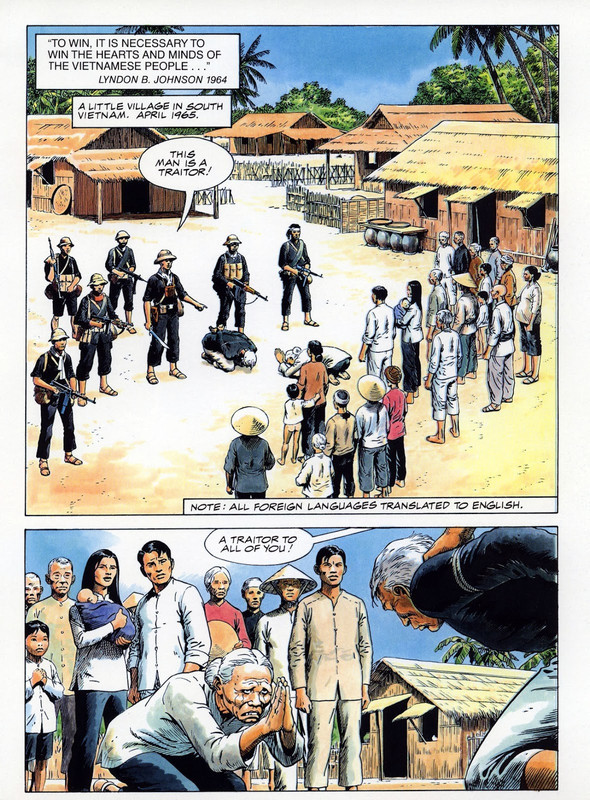 There is a woman of the village, with a baby. The VC leader denounces the village leader for sell out to the Americans and says they will pollute them, just as the French did "This woman" and he grans her by the chin and slaps her, while holding a bayonet. He then cuts the chief's throat, saying he will never allow the Europeans to control them, again. He then calls for volunteers to join. He asks the husband of the woman with the child and he refuses. Others join and the rest of the village is forced to store rice and weapons for the cadre. The young woman is of mixed blood, which was often treated harshly in Vietnam, as well as other Asian cultures. The VC depart and we then see a similar scene, with an ARVN unit, with a US Special Forces advisor. They are looking for the VC and their weapons cache. Le, the young man with the mixed race wife, is uneasy, worried that they will find the weapons and consider them VC, potentially wiping out the whole village. A soldier calls out and the produce a crate, loaded with American-made M-1 carbines. They ask whose hut the weapons were in and Le reacts, then runs away, as the soldiers shoot at him. his wife tries to stop them. Le is hit several times and falls, at the edge of bamboo forest. The villagers are rounded up, for resettlement and the village is put to the torch, to the protest of the young wife...  The villagers are marched out of the burning village and the elderly wife of the dead chief is pulled away from his grave. They are loaded into helicopters and taken away, as the wounded, but living, Le watches. The story then cuts to the US, where young Jim Brett is enjoying his graduation party, after finishing high school. he tells his friends he is off to Columbia University, which they question how he will afford it. He says he has ROTC lined up, which will cover what his dad can't. They aks about Vietnam, after he graduates college and he assures them that the war will be over before then. Jim attends college, where he finds things are a bit different from high school, including protests against Dow Chemicals (makers of napalm and Agent Orange), as well as signs that ROTC teaches people to kill. I must have missed that class, over my 4 years in Navy ROTC. One of the distractions from his study is a young lady, named Cookie (seriously? What is this; Gidget?) and he is also neglecting his ROTC courses and gets some feedback from his instructor 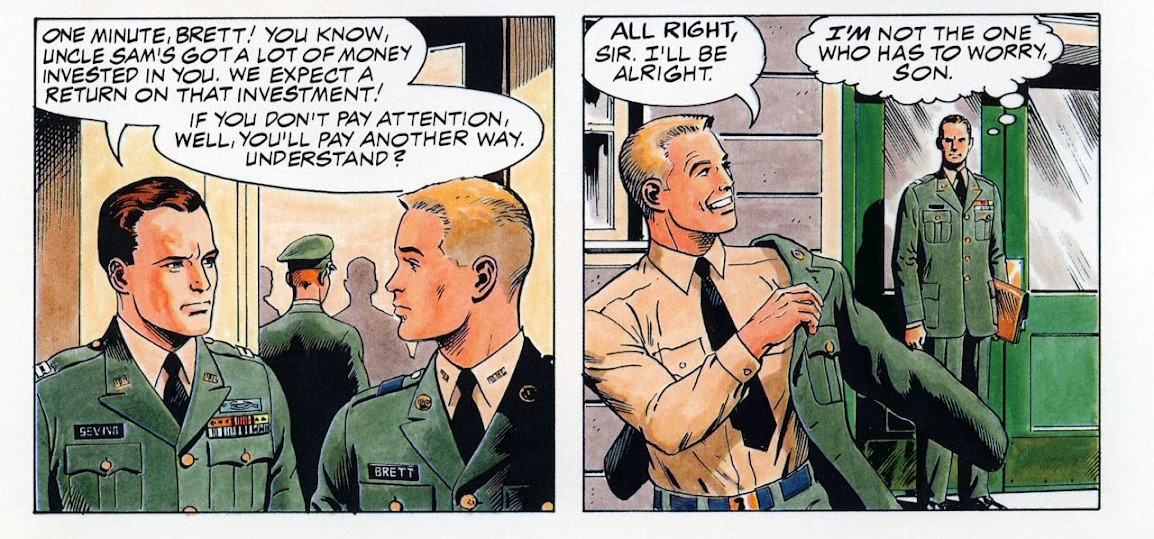 I can't speak for the Army ROTC program, especially of the Vietnam Era; but, the basics of ROTC, in my time, was that you trained to be a reserve officer, spend a short tour (2-4 years) on active duty and then revert to the reserves, for another period of time. The Navy program was a little different in that we went in as active duty USN officers, and not reserve officer (USNR), with a commitment of service comparable to the time to achieve our degree. There were also state sponsored ROTC scholarships and ROTC could be taken as an elective. In the Vietnam Era, at some universities, ROTC was a compulsory course. Those already enrolled in college could apply for a 2 or 3 year scholarship, depending on the amount of study that had finished. Under the terms of the scholarship, you had to participate in classroom and drill, plus maintain a minimum grade point average. Failure to do so could result in loss of scholarship and the requirement to pay back the governments investment with active duty military service, as an enlisted soldier. In other words, flunk out and you were off to the Army, as a grunt, not an officer. However, if you had the right political connections, like Ross Perot, you could get out of your military obligations. Cookie urges Jim to quit ROTC but he says if he quits, he will likely be drafted. Cookie doesn't believe the government would do it and Jim listens to her.....  Jim decides that crawling through the mud is for the birds and goes to see the First Sergeant. He had qualified for OCS and requests permission to transfer to the program; and, after 8 weeks of training and 30 days leave, finds himself crawling through mud, in Vietnam. The only difference is that, now, he is expected to lead the patrol. He is clueless; but, he is paired with an experienced ARVN officer and a veteran platoon sergeant. They steer him the right way and they get through their first fire fight. The lesson learned is to hold their position until darkness, when Charlie will withdraw. If things get bad, they call in air support and artillery fire. Mostly, Jim learns to loosen up a bit. However, they forgot to tell the VC that and they start taking machine gun fire. Jim turns to the sergeant for suggestions, and he orders the M79 grenadier to drop an HE (high explosive) round on the enemy and then they charge the position. The tactic work, as the grenade round hits the machine gun nest and either kills, maims or disorients, giving the soldiers time to rush the position and hit them hard, while they are off balance. Jim asks what the next step is and the sergeant says they call in air support, before it gets dark, otherwise they are on their own. A Marine fighter-bomber squadron responds.... 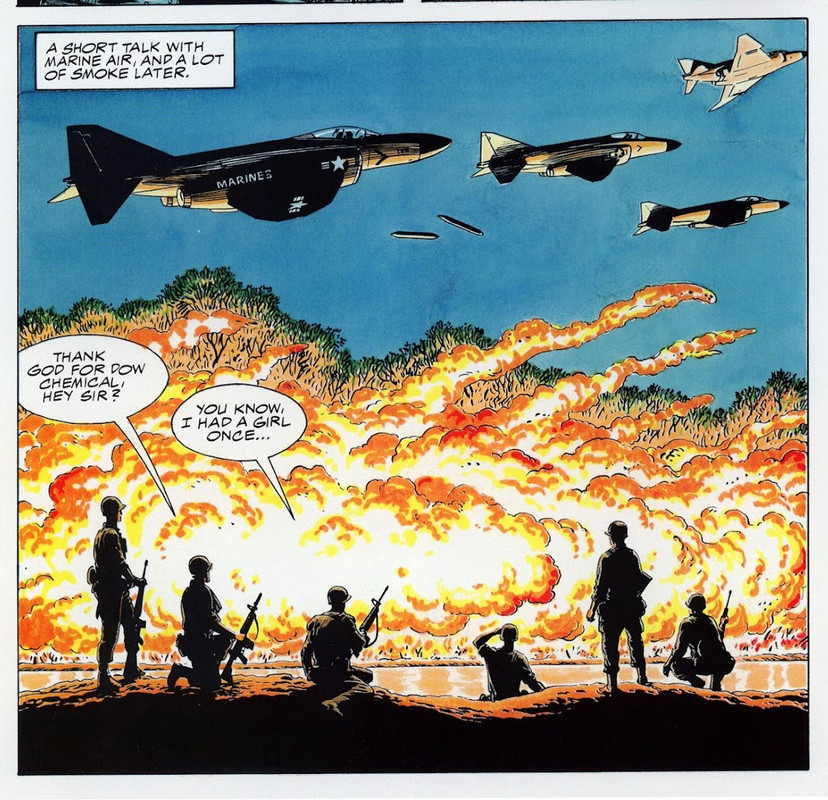 After the fighters depart, they get a body count and Brett learns the ways of mathematics, Vietnam style.... 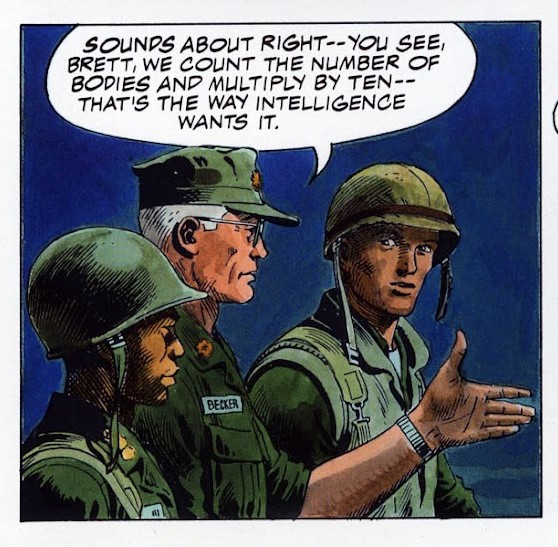 Here, we see the difference between doing a Code-approved book and one without outside restrictions. First, we had a naked Jim and Cookie, in his dorm room (strategically covered, though, since nudity is far more upsetting than violence). Then, we have use of a certain word, favored by Mrs Slocombe, in Are You Being Served?, but in a different context. However, the point I am referring to is language in the Code that prohibits the depiction of governmental authority as being corrupt or callous. That aspect was more likely to be enforced in the 60s; but, you weren't going to find war comics, in the 70s, which showed Army officers outright lying about enemy strength, to inflate body counts, for political capital. However, it was a very common practice as body count was one of the few measurable elements of the war, since territory was not being taken. We also hear of soldiers taking ears, as trophies, with those trophies helping to determine the body count. Jim is counseled by his captain, who says he did good, listening to his sergeant and then tells him to learn to relax and gives him a pass, to do just that. then, the captain and the sergeant share a hand-rolled cigarette, that I don't think contains tobacco. The next day, Sgt Lopez (aka "Lucky") takes Lt Brett into Hue, the ancient imperial city of Vietnam, where they shoot photos of the Imperial Palace. Lopez remarks that the trouble began there, as a French trader, who felt he had been cheated by the local government, tried to take the city, by force, and failed. Lopez takes Brett to a French colonial house, where he meets Major Bui, an ARVN officer, who remarks that the captain is breaking the new lieutenant in the right way. They meet their hostess, Madame Hoa, and Sgt Lopez says that Captain Decker requested that she show Lt Brett how to relax. She smiles and leads the men into a parlor, where awaits a group of experts in relaxation....for a reasonable fee. 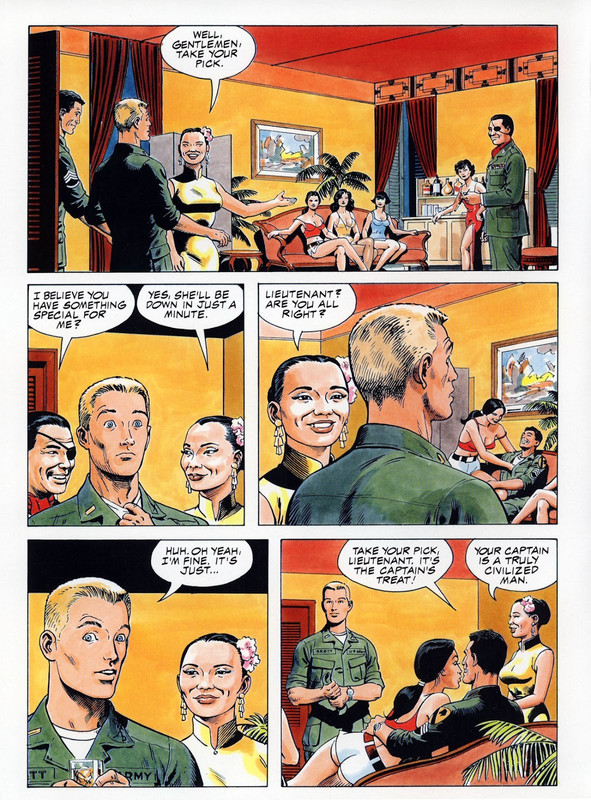 The major's special treat arrives, in the form of the Eurasian woman we saw in the village, at the beginning, dressed in a sheer, short nightgown. Brett is stunned by her beauty and the major offers her to him, as his gift. Madame Hoa directs the woman, Nhi, to take the lieutenant to her room. Nhi takes the young American to her bedroom, where they have milk and cookies and play a game of Go Fish. Well, if it had been a Code-approved book, maybe. Nhi removes her gown and Brett sees marks across her back. they were from Major Bui, who prefers women with foreign blood, for his....special tastes. She feels empathy for Jeanette, a blond Frenchwoman, who will likely be the major's companion, for the evening. She then asks Jim if he wants her to undress him and he stammers out, "no." Bass notes and whammy bars fill the air, as we cut to the jungle. We find Le, alive and leading a VC cadre, writing of seeing his wife and child die, when the soldiers came, as he is warned about an approaching helicopter.  Le survives and remarks that they will be ready soon, and then things will change. 6 months later, Lt Brett is with Nhi. She was purchased by Jim and given her freedom and they live together, in Hue, near the base. Jim has to eave her and report in. Outside Hue, Le's cadre meets with others and learns that the operation is much bigger than he thought. They cannot conceal everyone in bunkers and they are harassed by gunships attacking their camp. Le's men suffer casualties and he helps the medic treat the shrapnel wounds, hoping that the enemy does not score a direct hit. Christmas, 1967, finds Bob Hope putting on a USO show. Brett and Lopez are in attendance and we see that Jim's attitude to the situation in Vietnam has changed, in part due to personal reasons.... 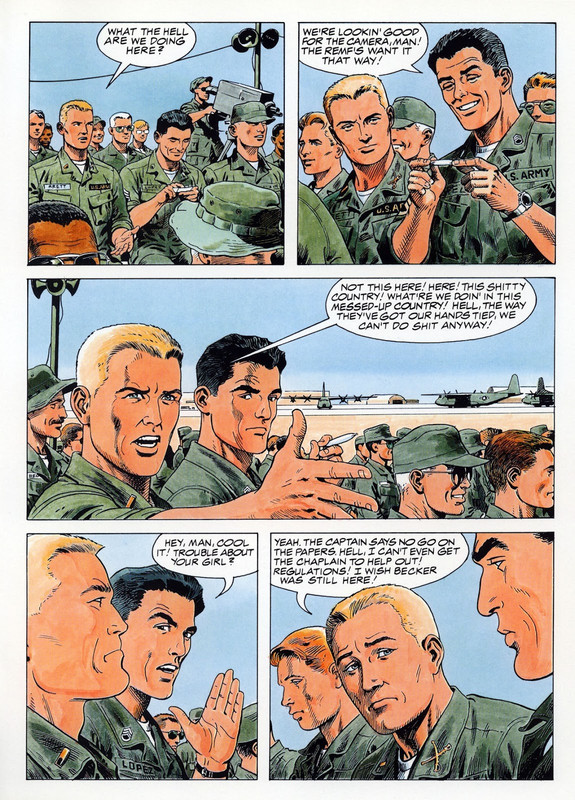 Most likely, the situation Jim is upset about is a denial by the Army to gain permission to marry a foreign national and for her to be brought home with him. We also learn that Decker is gone and, based on Sgt Lopez's reaction, most likely dead. They sit back to watch Ann Margaret sing and give some ammunition for the soldiers there, if you know what I mean. Lopez suggest talking to Major, now Colonel, Bui, who always seem to have connections. Col Bui is most helpful...for a price..... 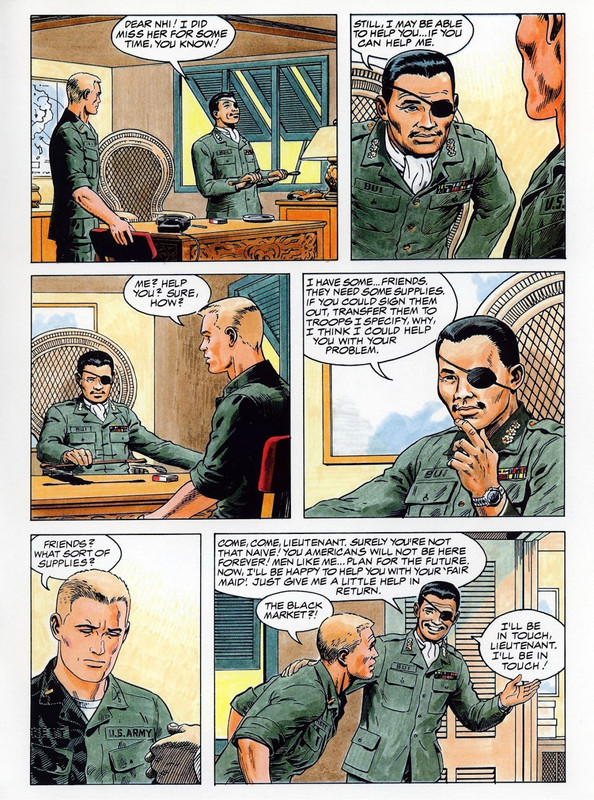 Jim and Nhi celebrate Christmas, together and Jim asks her to marry him. We cut to jungle, where Le is part of a column, moving through the night and the rain, which provides shelter from air atatcks. However, when they cross a road, flares go and men scatter. le and many other end up lost and away from their units.  Later, Jim meets with Col Bui, having provided the "supplies" he needed. Bui is pleased and says Jim will soon have his papers. He prepares to depart for leave, during the Tet holiday, when his plans are interrupted.... 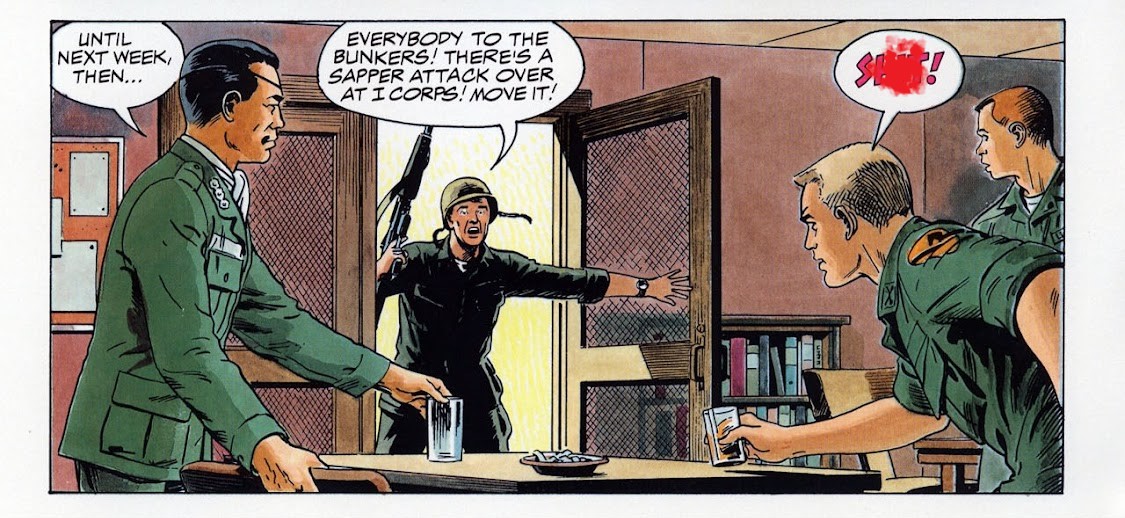 It is the beginning of what became know as the The Tet Offensive. On January 30, the VC and PAVN launched coordinated attacks, with more than 80,000 troops, with attacks in Saigon, Da Nang, Nha Trang and Pleiku, as well as 36 of 44 provincial capitals. Hue was a major target, as it housed the ARVN 1st division headquarters. The PAVN & VC hit with a division-size force, on January 31. The ARVN 1st Division held out in their fortress HQ; but, the PAVN and VC overran much of the city and established control, while the ARVN citadel was cut off. They had lists of enemies of the states and began rounding them up and summarily executing them, while others were marched away, for "re-education" and were never seen again. Estimates range between 2,000 and 6,000 civilians killed, mostly consisting of teachers, lawyers, government officials and other civic leaders, plus any who opposed the Communists or didn't provide enthusiastic enough support. The battle commenced to retake the city, with ARVN reinforcements and and American task force, made up of elements of the 1st Marine Division, the 1st Cavalry Division and the 101st Airborne Division. After the initial attacks, these elements launched counter-attacks, beginning with the Marines and then 1st cavalry attacks on the PAVN supply lines. Slowly, day by day, block by block, the American and South Vietnamese forces retocck the city and pushed the PAVN out, until by February 22, the city was in the hands of the US military and ARVN forces. The back had been broken of the PAVN and VC and they had withdrawn. Elsewhere, the attacks were similarly repelled, with the recapture of territory initially taken by the offensive. In the end, US and ARVN forces had driven off the PAVN and VC, inflicting heavy casualties among them. However, in reporting in the United States, the focus was on US casualties and footage of desperate fire fights, without context. Less emphasis was made of the ultimate victory of the US and ARVN forces than the initial gains of the PAVN and VC. To the soldiers who fought the battle, the media coverage sounded like they had lost the battle and the war. That is an over-simplification; but, the fact was that coverage of the Tet Offensive shocked average Americans, as, for the first time, they saw American soldiers and Marines fighting desperately for their lives, against an enemy that their government said would be defeated by American military might. This was supposed to be the same Army the fought the Battle of the Bulge (same Army division, in fact); but it barely survived an attack by a power far less than the Wehrmacht? few outlets were giving full context, nor was anyone educating the public about the difference in fighting those two wars. in the end, it bolstered support for the Anti-War movement and had a major effect on the 1968 Election. Back to the story. The PAVN and VC hit the outskirts of the city, at the positions manned by Lt Brett and the 1st Cav, as well as ARVN forces. They use claymore mines and other defenses to inflict heavy damage on the attackers, while keeping up a high rate of fire. They repel the attack and survey the carnage, when word comes in that they are moving out to retake the city, which is in the hands of the enemy, this being a diversionary attack, to pin them down. In the city, we see Le and his cadre removing political prisoners and re-educating the populace....  1st Cav moves in on the outskirts of the city and begin their block fighting. They link up with ARVN forces, then move out, but come under sniper fire. They work quickly to eliminate the sniper. The fighting continues, street by street, while US forces are working under constraints....  Finally, they get word that the gloves have come off and they can call for air strikes and artillery. Artillery barrages begin, on the ancient city, as Le watches, with many of his friends killed in the bombing.... 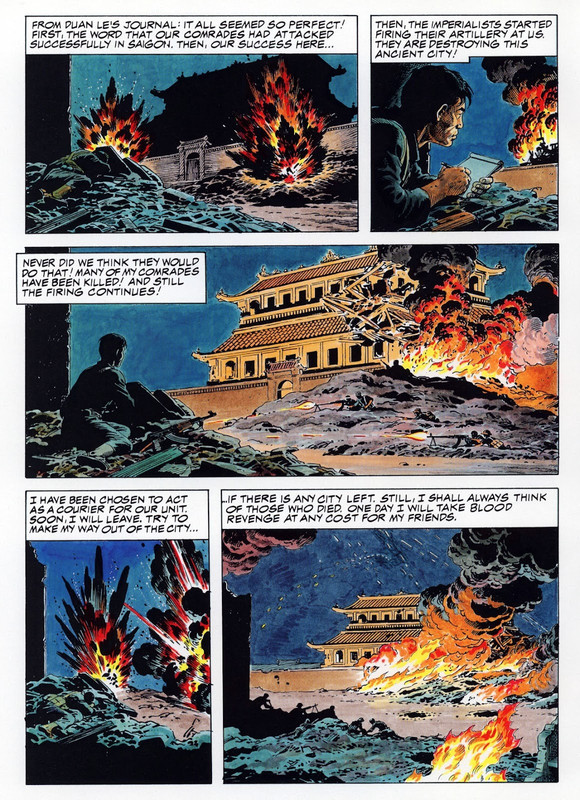 Fighting is desperate, as the enemy forces man strongpoints and use rockets and machine guns to hold off the Americans. They call in a gunship and wipe out the strongpoint, then hit a building filled with enemy soldiers with "willy peter" (white phosphorous) grenades, turning the building into an inferno. They shoot the enemy as they emerge fromt he flames, wiping them out to a man, angered by their own casualties. Lt Brett realizes where he is, only two streets away from Nhi's apartment. Jim abandons his men to go see that Nhi is safe. Sgt Lopez argues, but Jim is adamant. He still realizes he is being an idiot, but he can't help himself. Meanwhile, Le is picked as a courier, to get word of the battle back to Hanoi, so that their sacrifices can be used as a porpaganda weapon. he makes his way down streets, alone, just as Lt Brett, trying to stay clear of the fighting, despite the urge to aid comrades. Jim gets to the house and finds Nhi safe, but then Le bursts in, seeking cover.... 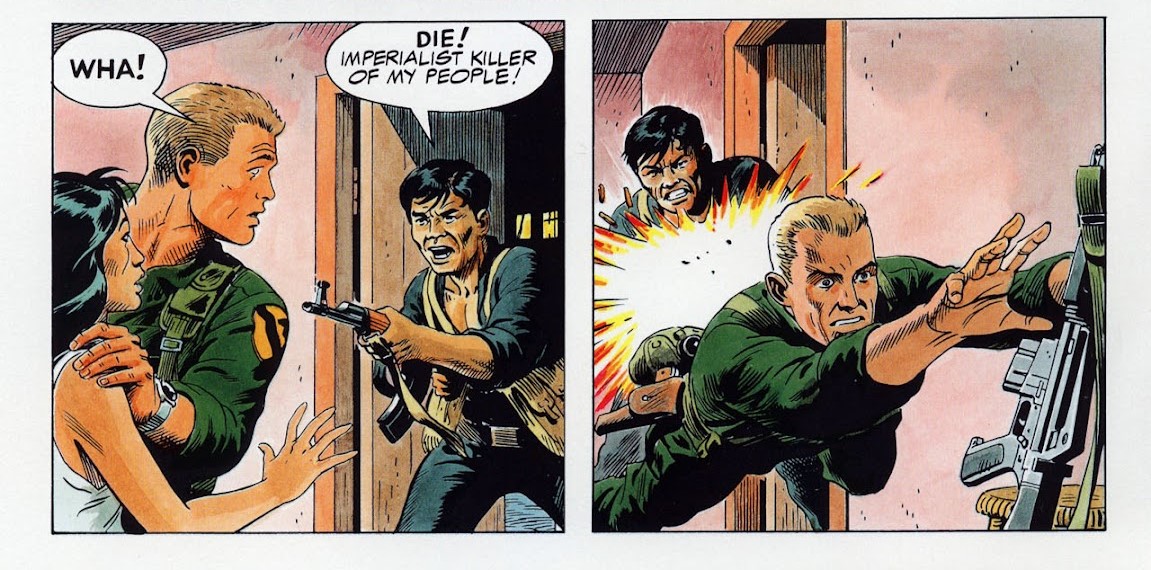 Jim dives for his weapon, but doesn't make it and takes a burst in the chest, killing him. Nhi screams out at the death of her fiance. Le, recognizes his wife.... 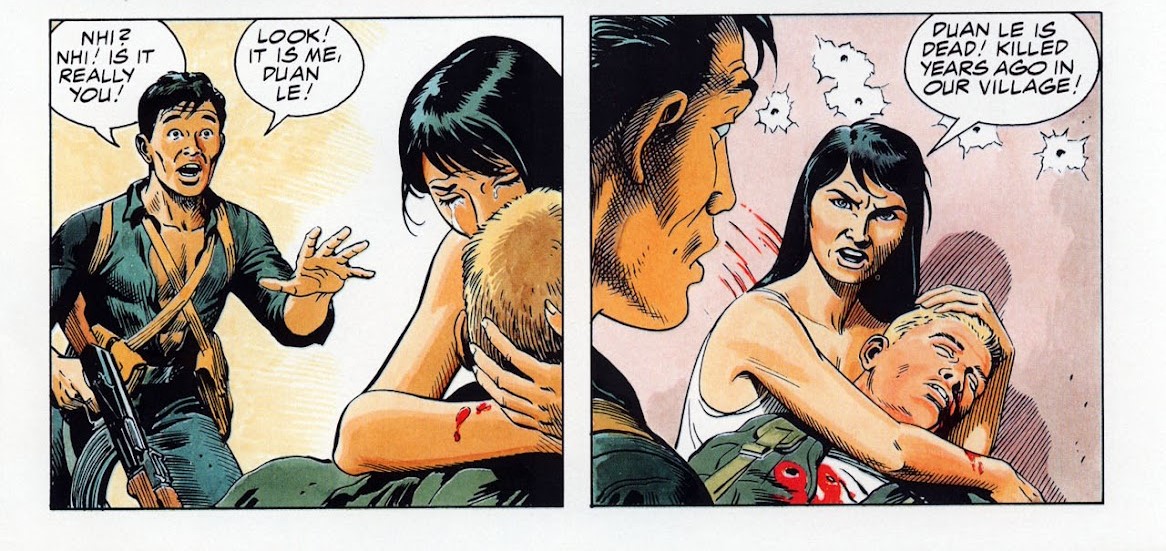 Nhi yells at him, that their child starved to death and she was sold to a brothel. He has killed the man she loved, the man who bought her out of a brothel and wanted to marry her. The man who came through the fighting to make sure she was alright; and, now, he is dead, at the hands of her former husband. She pulls Jim's sidearm from his holster and points it at the stunned Le. he reacts, opening fire with his AK. Nhi lies dead, next to Jim, Le is frozen by what he has done. Then the door of the apartment opens and Sgt Lopez shoots Le dead. We end with Sgt Lopez reporting to the company commander, remarking that Col Bui said he would take care of burial of Nhi, as they observe coffins of US soldiers, being loaded on a transport plane, to carry the dead home. Jim Brett is laid to rest and his parents receive the flag that draped his coffin, "on behalf of a grateful nation." A salute is fired by an honor guard. We see a New york Times headline that US troops were massacred in the Tet Offensive and urging the US to withdraw from the "insane war". 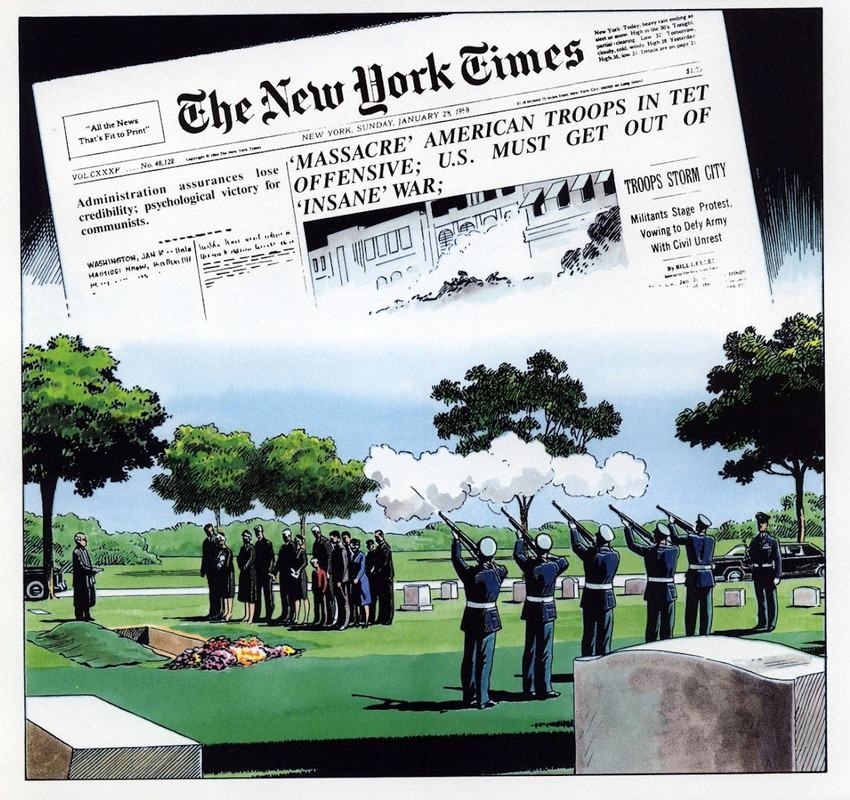 We end with Sgt Lopez observing Col Bui and a woman burying the ashes of Nhi, in a cemetery. A New York Times headline follows, showing the signing of the Paris Peace Accords, bringing an end to the fighting. However, afterwards, the North overwhelmed the South with 21 divisions and captured the capital of Saigon, uniting the country under Communist rule, bringing the true end to the fighting, within Vietnam (until Vietnam invaded Cambodia and found itself in a war with China). This is a complex work which illustrates the war, from both sides. For Jim Brett, it is an American war and he attends college, with an ROTC scholarship. He can't keep his head on his studies and ends up washing out of the program. However, he is able to go to Officer candidate School and still go to Vietnam as an officer, instead of a foot soldier. Not that it brought him any protection. it also didn't give him the training to lead in combat. Thankfully, he had an NCO who knew his job and gave him on-the-job training. Meanwhile, Le refuses to be in the fight, but finds a personal reason, when the ARVN comes and locates the VC weapons stash. he abandons his village and family and seemingly is killed, but survives. However, his village is torched and he believe his family killed. He now has a personal stake in the fighting, to gain revenge for the deaths of his wife and child. This opens him to the propaganda of the Viet Cong and he becomes a valued member of his cadre. Nhi is taken away, believing her husband dead. She is already on the fringes, as a mixed race woman and she is considered suspect, because of the weapons and Le's actions. The child dies, as they are left to starve and she is sold to a brothel, where she becomes the plaything of a Vietnamese major, who likes to whip women of European blood. The focus is most heavily on Jim Brett, but Le's journals bring us the other side of the coin, while Nhi shows those caught in between and the suffering of the innocents. The work itself has some curious elements that I would like to learn more about; but, I can find no interview with Murray about the graphic novel. One of the things that makes me curious comes in the art. Jim Brett is shown in Army ROTC uniform and in US Army utilities, with 1st Cav shoulder patches. However, in the boot camp scene, he is wearing a camouflage helmet cover that looks like the Marine pattern. It makes me wonder if they didn't change the story, at some point and have Jim Brett in the Marine Corps. His DI displays the Combat Infantry Badge. That is an Army decoration; the Marines do not wear such a device. During the early patrol scene, brett wears his flak jacket, but the rest don't. Army and Marines both wore them; but the Marines were big sticklers about wearing them. However, that may be an artist choice or maybe more of an indication that Brett is new there and more likely to wear it than others, who left them behind to reduce the weight they carry in the field. Later, when Sgt Lopez shows Brett Hue, they are depicted wearing what are most definitely Marine utility caps, with the 8 points that differentiated them from the Army. The US Army of the Vietnam Era wore OD Green ballcaps. Previously, in Korea, the US Army wore soft utility caps, with a rounded crown, like you see in MASH, with Col Potter and Major Burns (more often than other characters). Those were later brought back, in the 80s. Heath draws definite points, on the cap. Captain Decker is also depicted in one, when they assess the damage after the battle. Also, the air support they receive is from Marine F-4 Phantom IIs ad they arrive at Hue, in marine helicopters. That isn't necessarily significant, as the Marines had their air arm in that sector, which might have been on stage for support. However, 1st Cav had a dedicated air wing, with their own helos. The Marines led the initial counter attacks on Hue; which makes me wonder if, at some stage, Brett was supposed to be a Marine officer and the story changed. Regardless of whether these are changes in the script, mistakes, or based on experience, Heath draws everything with his usual accuracy, including the streets and buildings of Hue, based on photos of the battle I found. Heath was always noted for his attention to detail. Like The 'Nam, this is telling things from the soldier's POV, while adding an enemy perspective. It is able to use more of the language, though no F-bombs. It filters a lot of historical detail, like Bob Hope and Ann Margaret in USO shows. The only problem is that Ann Margret toured Vietnam in 1966 and 1968, not 1967. She toured with Hope in 1968 only, and was just with Johnny Rivers and his band, in 1966. Raquel Welch toured with Hope, in 1967. Maybe memories got crossed, as Murray was in Vietnam in 1968. Again, the politics of the war don't really enter into things, other than the campus display we see, when Jim is a student, and that Cookie is part of the Anti-War movement. Then, it is just the media depiction of the Tet Offensive as a major calamity, rather than a large battle, similar to the battle of the bulge, with a similar outcome, that the enemy was pushed back and unable to launch further offensive operations, until after the US withdrawal. The New York Times headline we see has a date that says Sunday, January and then the date is obscured. Since the attack occurred on January 30, that can't be correct, as the Sundays of January, 1968 were the 7th, 14th, 21st and 28th. Basically, this is doctored to depict talk within the media to withdraw. In that, it acts as propaganda and not historical fact. There were editorials from different points and I am sure there were headlines quoting opponents about withdrawing; but the use of the Times headline suggests a reconstruction, not a fabrication. In the few interviews I have found, Murray was very critical of media coverage during the war. He has points; but, it is as broad a generalization as some media accounts, which suggested atrocities were commonplace, and not extreme reactions. Journalism is supposed to be the search for truth; but, it is dependent on the reporter and even the best reporter is never fully unbiased. TV was a big game changer in that, with more rapid reporting and less time for fact checking or nuance. The soundbite replaced the in-depth article. Even Walter Cronkite wasn't free from that. We have one more example, from Marvel Comics, to explore; and, this one is definitely from a US marine perspective. Next time, we look at Semper Fi, Marvel's short-lived companion to The 'Nam, featuring stories of the US Marines from several periods, but with a recurring look at Vietnam. Before we leave, here is a 1987 interview with Doug Murray, conducted by Charlie Rose, for the CBS News Nightwatch Note the discussion about the changing culture and addressing the Vietnam War, as well as separating the politics of the war from the soldiers who served there. Both Platoon and The 'Nam were about relating the soldier's story, rather than the political story or the historical perspective, even though the politics of both the 1980s and the 1960s still found their war into such discussions. |
|
|
|
Post by codystarbuck on Dec 19, 2023 21:08:04 GMT -5
ps For illustration, here are Marines from the Vietnam War, wearing their 8-point utility cover (cap).... 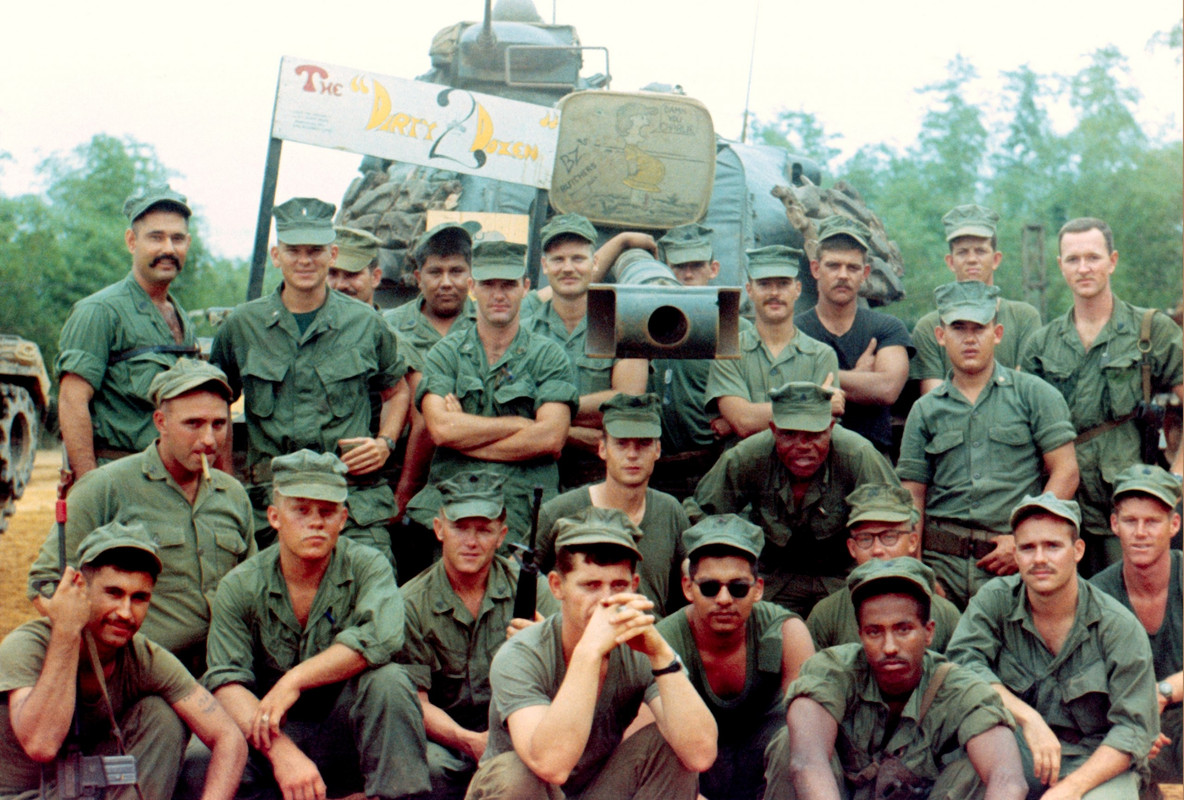 ...and here is an Army officer, wearing their ballcap....  There is no way Russ Heath could mistake one for the other, unless either there were changes to the script and which unit they were depicting; or, if Heath was using photo reference and didn't realize he was looking at Marines, instead of Army (he was US Army Air Force, from 1945). Since the Marines were the only ones to wear that style of cap (aside from Navy divers and corpsmen, though theirs lacks the USMC globe and anchor, on the front), and had since WW2, I can't see how Heath wouldn't have known it was a Marine cover. That is why I lean to the story changing from Marine to Army...or a miscommunication. The Battle of Hue involved a large scale Marine presence, though, as I said, the 1st Cav and 101st Airborne were also involved in retaking the city. |
|
|
|
Post by codystarbuck on Dec 30, 2023 1:51:53 GMT -5
So far, we have mostly seen the Army side of the Vietnam War, both with Special Forces advisors and regular Army units. The only look at the Marine Corps involvement has been in Charlton's Fightin' Marines, with Shotgun Harker and the Chicken. However, that might as well have been the Army, as the writers and artists at Charlton, aside from Will Franz and Sam Glanzman, didn't seem to know the difference and wrote stories that could be inserted into either Fightin' Army or Fightin' Marines, or any of the other Charlton war comics. This entry is about a pure US Marine Corps comic, which isn't interchangeable: Marvel's Semper Fi. Semper Fi features tales of US Marines, from throughout the history of the Corps, but filtered through one family, the Whittier's, who have been Marines since the American Revolution (the US Marine Corps and US Navy were founded in 1775). The short-lived series featured stories of Marines in the Revolution (drawn by Sam Glanzman), during World War I, World War II, Nicaragua, China, during the Boxer Rebellion, Vietnam and even one story set in Lebanon, in 1983, when the Marine Barracks was blown up, by a car bomb. The series was written by Michael P Palladino, who served in the Marine Corps, from 1965-1969, according to a Los Angeles Times short article about the then-new series. I haven't been able to find out much more about him or the evolution of this project; but, the core group of artists (Sam Glanzman, John Severin ad Andy Kubert) were veterans of the short-lived Savage Tales revival, under Larry Hama. Hama is a consulting editor on this; so, he might have conceived it, though Don Daley is the editor of record. The series premiered in 1988, under Tom DeFalco's reign, as EIC, though I wonder if it originated under his watch or Jim Shooter's. Before we get to the series, a little historical background on the US Marines Corps, in the Vietnam War. The Marines were involved from the start, when Lt Colonel Victor Croizat was assigned to the US Military Assistance and Advisory Group (MAAG), to the Republic of Vietnam, as a liason officer. The marine presence was to advise the RVN on the creation of the own marines, to support their small Navy, which largely dealt with coastal defence and patrolling of the rivers of Vietnam (especially the Mekong). In 1962, the Marine presence was increased, with the arrival of Medium Helicopter Squadron 362, which provided air support for operations. In 1964, Marine Advisory Team One arrived, collecting signals intelligence. Following the Gulf of Tonkin Incident, Gen William Westmorland requested two Marine battalions to protect the air base, at Da Nang. Their role was expanded, as more Marines were sent to Vietnam to take part in combat operations, in the I Corps area, near the Demilitarized Zone (DMZ), separating North and South Vietnam. Marines were also brought in to strengthen the former Special forces base at a place called Khe Sanh. When the Tet Offensive was launched, in January of 1968, the Marines were in the thick of it, fighting to retake the ancient imperial city of Hue back and during the siege of Khe Sanh. By 1972, the Marines were being withdrawn, turning over more of their areas to the ARVN and other formations, but the Marines were involved up to the end, defending the US Embassy, in Saigon, as the city fell to the North Vietnamese and also in then in the Mayaguez incident, in 1975, when a US merchant ship was seized, in disputed waters, by the Khmer Rouge, in Cambodia. Marines from the 1st battalion/4th marines, in Subic Bay and the 9th marine regiment, in Okinawa. They assembled a force to retake the ship and free the crew, which was ultimately successful, though 3 Marines were left behind, during the extraction of forces, and were executed by the Khmer Rouge. Marvel's Semper Fi begins with a story set during the Battle of Hue.  CPL Miles Whittier and PVT Willie Thornton are part of the Marine force sent into the city, to rescue the MAC-V compound and retake the city. They come under heavy fire, from a machine gun, in a nearby building. They take cover behind a tank and Thornton is hit.... 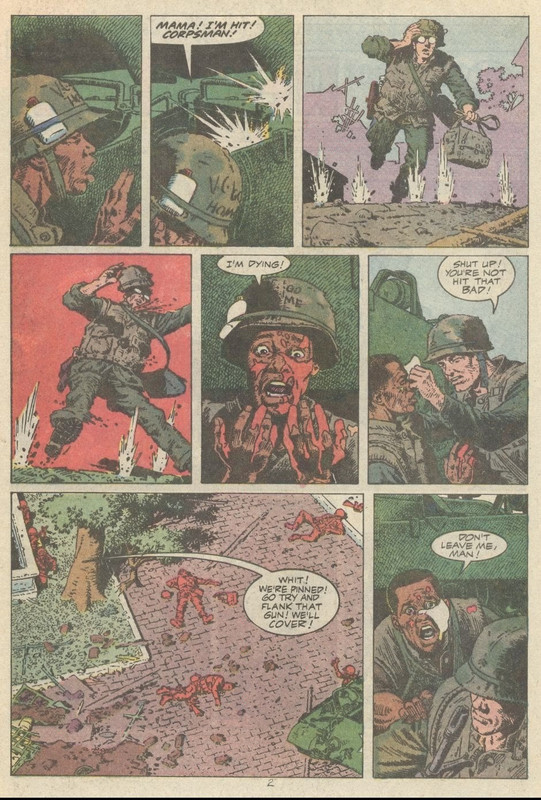 They are pinned down. despite Thornton's pleas and threat to shoot him, Whittier leaves their position to try to outflank the sniper. Thornton lays down covering fire and Whittier gets across the killing ground of the street, but gets hit by the blast of an explosion and is knocked out. We flash forward to July, 1983, and a Marine reunion, in Washington DC. Miles Whittier is older, with grey hair, and he runs into Thornton, who is angry and demanding to know why Whittier didn't come back... 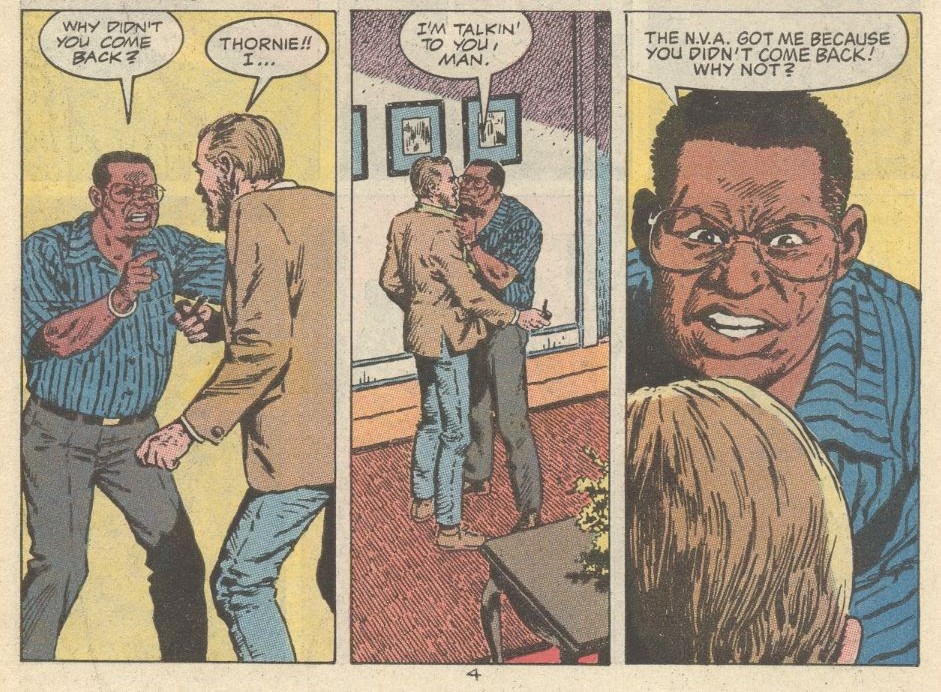 Back in 1968, Whittier comes to, injured and his M-16 has been badly damaged by shrapnel. Armed only with his K-Bar fighting knife, he outflanks a VC RPG gunner and kills him. He takes his AK-47 and makes his way toward the sniper position. He runs into more VC, in an alley and a fight ensues. he ducks through a door and tosses back a grenade. he turns around to find a mother and children hiding there. Her husband, a teacher, has been killed by a VC soldier, who Whittier killed, when he entered. The widow leads him into a tunnel and bunker underneath the building and they hide out. She treats his wounds, but he feels claustraphobic and anxious about being trapped in there, with the VC and PAVN crawling around. He gets up to leave and the widow shoots at him, afraid he will draw the VC to them. In 1983, Willie says he was captured and bayoneted by the PAVN and shows his scars. Under a handkerchief he has laid on the table, we see the barrel of a pistol. Mies wrestled the gun from the widow, but it goes off and she is wounded. He runs off, with the woman cursing him. He continues fighting his way to the sniper position and kills the sniper, then sees the PAVN moving in to surround Thornton. His AK is jammed and he is hit in the chest, as he tries to grab the machine gun from the dead sniper. In 1983, he shows Willie the wound. Thornton releases his anger and they reconcile and say goodnight. Miles finds his wife waiting up for him, in their hotel room and he tells her it was a mistake to come there.... 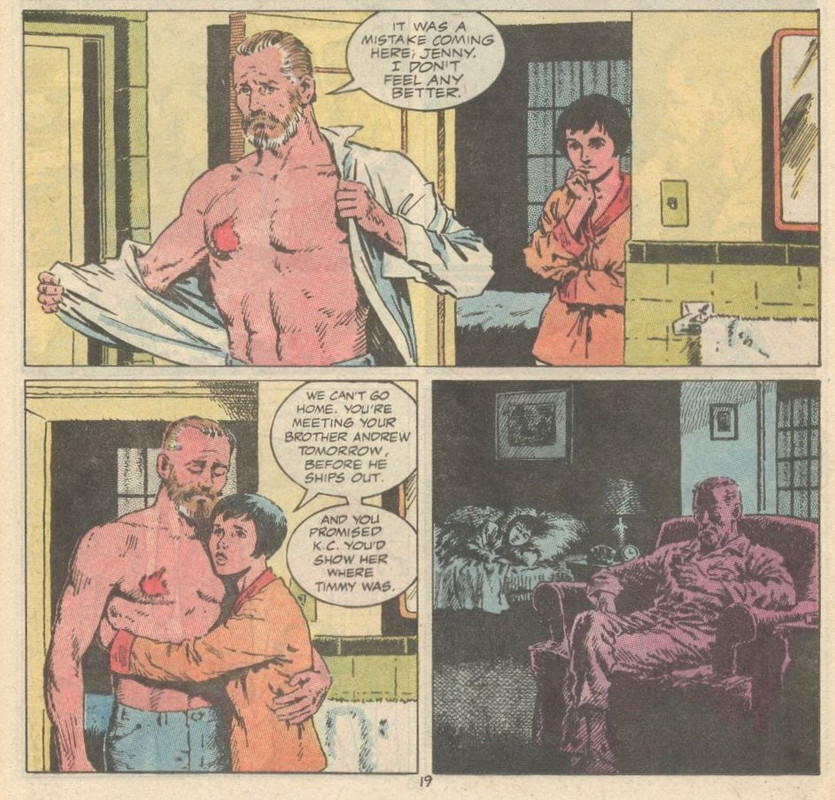 His wife tells him they are still supposed to meet Miles' brother, Andrew and he is supposed to show their daughter, KC, where "Uncle Timmy" is. At breakfast, KC says she wants to be a Marine, like her father and Uncle Andy. Miles scolds her and says the Marines are no place for a girl. He seems rather harsh in his retort. We then see them meet up with Andy, who is also a Marine. KC asks about Uncle Timmy and Miles takes her with him, to show her. 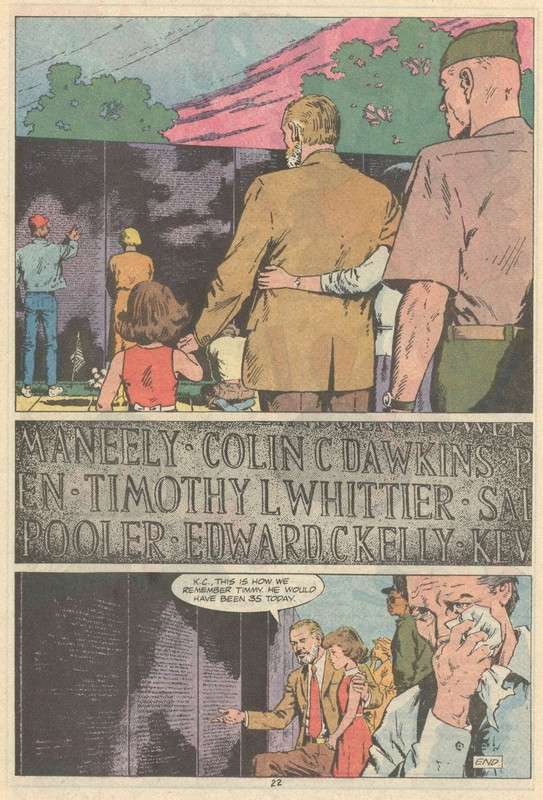 Here, again, we get the soldier's (Marine's) point of view of the war and the battles, particularly the intense street fighting of Hue. The closest the average American might know of this is from the second half og Stanley Kubrick's Full Metal Jacket.... Here, we see the tense fighting and the horror that the Marines went through, as well as the murder of innocent civilians by the VC and PAVN cadres, with their enemies lists. They singled out civic leaders, teachers, intellectuals and others of similar stature, in what was as much a class war as an ideological one. The educated were targeted, because they didn't buy into Ho Chi Minh's ideas of government, any more than they did Diem's. Miles is still suffering from PTSD and having to leave behind a comrade, to take out the sniper pinning them down. He sees death among the Vietnamese and causes further pain. he succeeds in killing the sniper, but is wounded, as he sees the PAVN capture Willie. Now, in 1983, he faces the brother he left behind. They find peace with each other, but not the world. Miles is still hurting. It informs how he reacts to his daughter's hero worship of her father and uncle, talking of being a Marine, herself, one day. Then, we see the family meet, at the Vietnam Veterans memorial Wall, where Miles shows KC the name of her Uncle Timmy, killed in Vietnam. This highlights the simple majesty of the Wall, as it gives a place for friends and families to reconnect with their lost loved ones, to reach out and touch their names and connect with their spirit (metaphorically speaking). This is the side of war that Hollywood largely ignored, with a few exceptions, though that was changing. In 1985, writer Bobbie Ann Mason wrote the novella, In Country, about a young woman's quest to know her father, who was killed in Vietnam, at the age of 21, and her Uncle Emmett, who deals with PTSD, from the war. It climaxes with a visit to the Vietnam Veterans Memorial Wall, where the young woman finds some answers and Emmett begins to heal. Just before that, in 1987, Francis ford Coppola filmed Gardens of Stone, about soldiers in The Old Guard, the formation who stand vigil in Arlington National Cemetery and at the Tomb of the Unknown Soldier and who conducted the funeral services and honor guards for the fallen, throughout the Vietnam War. People were starting to talk about the war; soldiers, sailors and Marines were starting to talk about the war and what it did to them and those they left behind. Healing was beginning, but it would be a long, long road. This story reflects that, though it is far from perfect. The basic plot is good and the story compelling; but, Michael Palladino's chopped dialogue adds little to things. Far more is carried in the art, from John Severin, a master and a veteran. The issue also features another Palladino story, with art by Sam Glanzman, which is set at Tarawa, in the Pacific, during WW2. It reminds us of the toll to take those little islands, to move closer to Japan and take the fighting directly to them and why the war in the Pacific was vastly different than the war in Europe.  Issue #2 picks up Tim Whittier's story, in July, 1968, in Quang Nam province. Whittier is a career Marine and is tired of trying to keep amateurs alive...and failing... 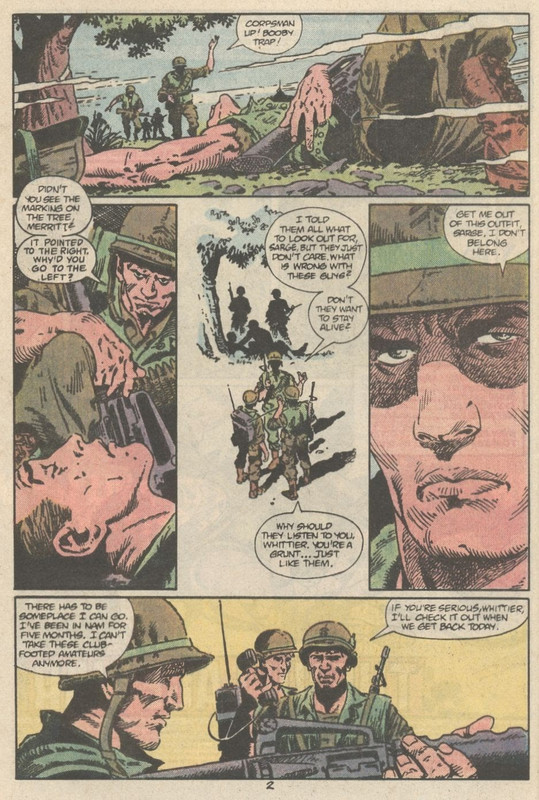 His patrol moves on to check a village and are ambushed by VC, Whittier is wounded and escapes. he hides in a hut, but is found by an old man. The old man hides him from the VC. 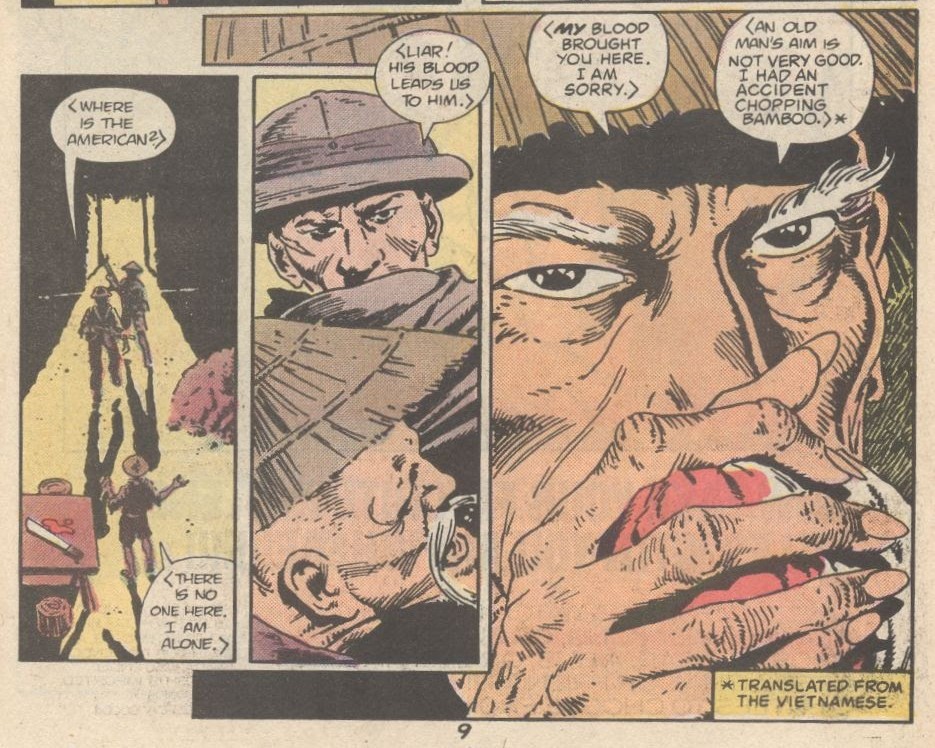 Whittier makes it out alive and is medevaced to the USS Sanctuary, a hospital ship, off the coast of Vietnam. There he convalesces, after his wounds are treated. While on the ship, he sees a group of orphans, who are housed there....  Whittier returns to his unit, where he sees a young Vietnamese girl who shows the Marines where the VC have planted mines. One of the Vietnamese soldiers says the VC will kill her for betraying them. Whittier makes it his job to protect her and sets up an ambush site, near her hooch. They spot the VC moving into the vilage and spring the trap, but some of the invaders outflank them and toss grenades into the hooch, killing the family. Later, we see the VC return and kill the old man who gave Whittier shelter. Whittier sits at base camp, bemoaning the uselessness of their missions. A fellow Marine suggests he check out the Combined Action Platoons.... 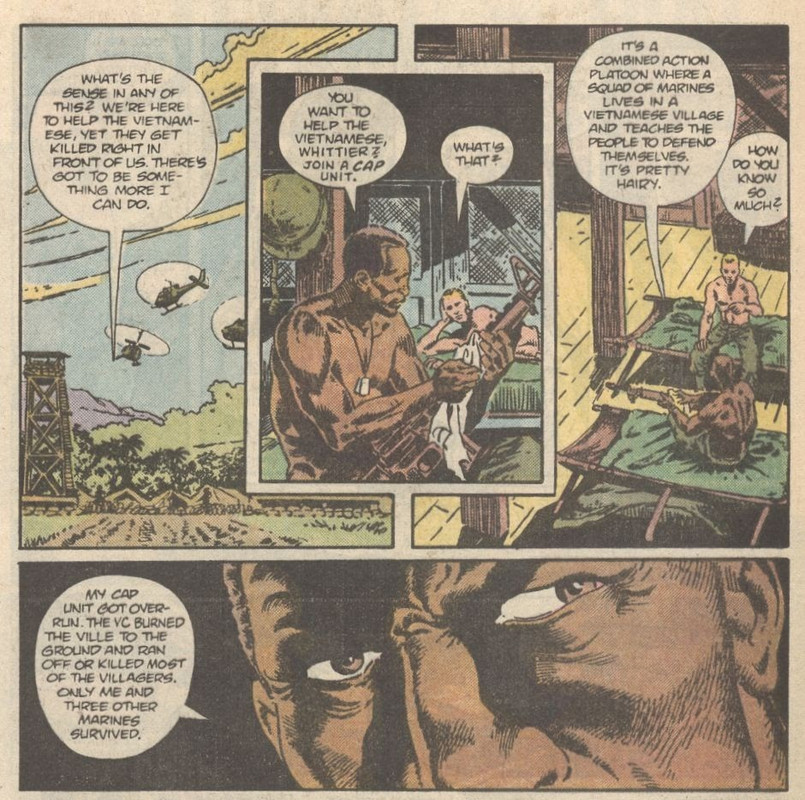 Whittier puts in for a transfer to a CAP unit and his request is granted. He receives his orders and transport to Phan Trong 3, a base where Marines and Vietnamese live, eat and work together, to create a cohesive force. In 1965, the US Marines implemented a new counter-insurgency strategy, called the Combined Action Program. The Marines were at odds with Army strategy of "search and destroy" missions, to root out and kill VC insurgents, with body counts as the only metric for measuring success, since no action was taken to secure territory by invading the North, as in WW2. The Marines, who had decades of counter-insurgency experience in Latin America and the Philippines disagreed with this strategy, as did Special Forces. Special Forces operated the Civilian Irregular Defense Group program, where Special Forces teams acted as the central structure of a combined defensive force, built of local militia, and mercenary soldiers, such as Nung and Dega tribesmen (the montagnards), who helped them create mobile strike forces to go after VC cadres, while others protected the local hamlets. The Special Forces version was more of a mercenary formation, sponsored by the CIA, often in more remote areas. The Marine proposal was to work with militia groups, to protect the hamlets and carry out civic projects to improve the lives of the villagers. They sought to deny the VC these village havens by winning "hearts and minds." The belief was that the 13-man Marine Rifle platoon (with a Navy corpsman) would be able to better train the militia into an effective fighting force, while they also built up the villages, with medical care, better defenses, better dwellings and improved farming and education. The Marine program was quite effective, in some areas. Like most things, it depended on the local implementation and the leadership. Here, we see Tim Whittier struggle with feelings of helplessness, as Marines are killed and children suffer, while poor strategies change nothing. CAP seems like the perfect solution, to him and he goes to become a part of it; but, we see the VC operating in the area, at the end. Due to the truncated nature of the series, this story does not get continued, so we never do learn how Tim Whittier is killed. We get no further stories of Vietnam, until issue #6, as KC Whittier finds her father's photo album, from Vietnam.  She sees a picture of her father, in 1967, infront of a sign, for the base at An Hoa. KC asks about the photos and wants to know more, but Miles doesn't want her to know and yells at her, sending her to bed, in tears. His wife has enough of it and tells him to stop crawling into his beer and tell them about it. He finally does, telling them of arriving in An Hoa, on a truck, which is ambushed by the VC. Miles and another Marine are pinned down and try to hold off the attacking VC until the local reaction force can get to them, with a tank and infantry. The VC hit the tank with an RPG.... 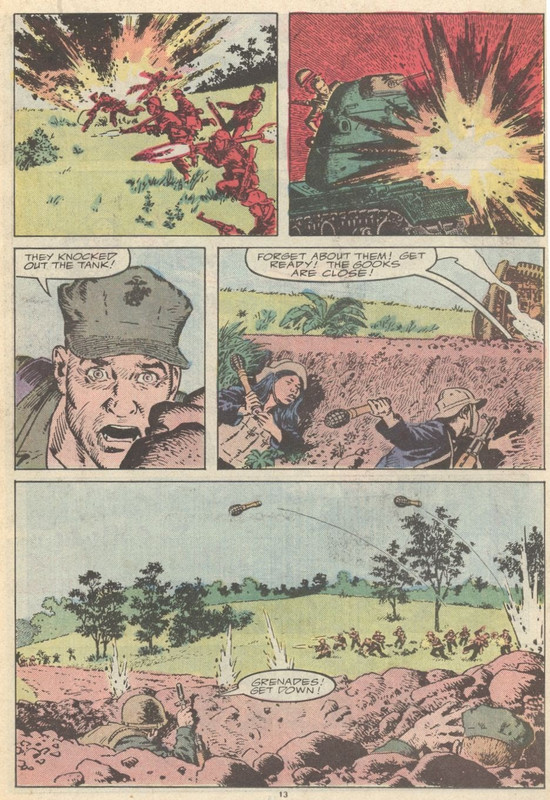 The VC renew their attack and it gets hairy, for Miles and his fellow Marine the reaction force gets closer and lays down suppressing fire, eventually forcing the VC back to the bush and they slip away. Marine air is called in to help secure the area and they drop napalmon the section of jungle, where the VC fled. Miles and his new buddy are taken to the base and the other Marine takes Miles' photo, by the sign. Miles' wife tries to comfort him, but he reacts in anger and goes out for a walk. Again, Palladino illustrates the PTSD that dominates Miles' post-war life, with the things he experienced, the friends and family he lost. He carries physical and mental scars of the war, things his wife and young daughter can never understand and things he doesn't want them to have to know or experience. many veterans, not just of Vietnam, avoided talking about their war experiences with their families, because they didn't want them to know the horror of war, especially veterans of heavy combat. It was nearly universal for the members of the 506th Parachite Infantry Regiment, the Band of Brothers, of the 101st Airborne, to keep their wartime experiences from their families, even as they attended reunions. It took the writing of the book and the mini-series to share those stories with the families. How do you tell your wife and young children that you killed men, to stay alive and that you saw you friends blown to pieces? Whay would you want to? That is the legacy of the combat veteran, the horror they experienced and the desire the shelter their families from that horror. The last Vietnam story is in issue #8...  This story deals with a "motivation platoon, at Marine corps recruit Depot, Paris Island. A motivation platoon is a formation of Marine recruits, who are overweight or underweight, not performing up to standard or otherwise need motivation to "get with the program." This is a more intense form of boot camp, with emphasis on getting in shape and getting the proper attitude to absorb training and be effective Marines. It can be instructive and it can be brutal punishment. In the story, we see a skinny, awkward Marine recruit, named Sanduski. he wears glasses, has two left feet and is a beanpole. the DIs dog him mercilessly, telling him to quit. He doesn't do it, though, no matter how much his body aches or how often he trips over his own feet. 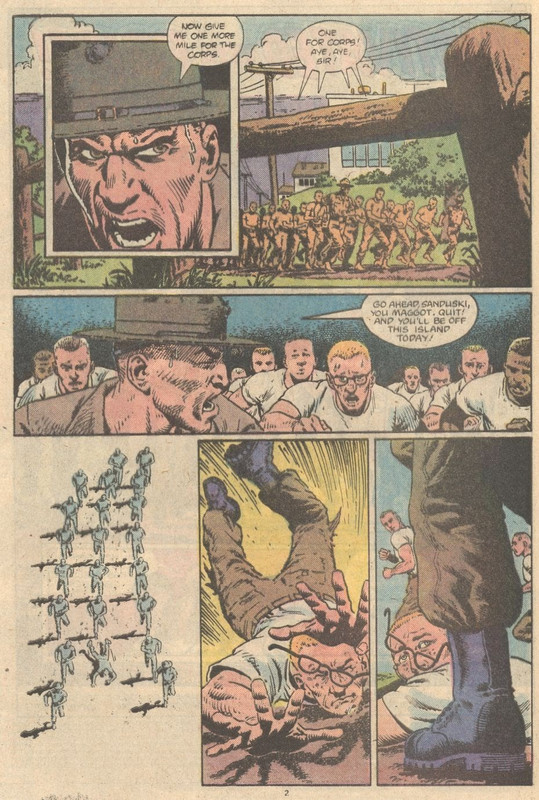 Sanduski trips and hits the ground hard, causing bruising to his face. After more drills and butt-chewing, a DI details him to report to Sick Bay to get his injuries seen to. There, he runs into a Navy corpsman, with an attitude problem and Sanduski threatens to tear him a new one, when the Navy doctor enters. The corpsman keeps his mouth shut and the doctor examines sanduski's injuries and concludes they are the result of physical abuse by the DIs and wants to report it. Sanduski argues... 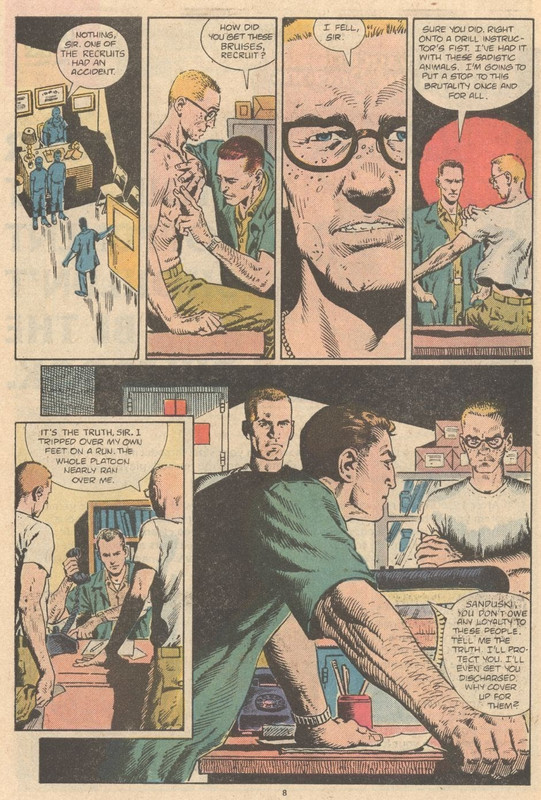 Sanduski is treated and sent back to the platoon. More drill and harassment comes and Sanduski struggles to knock out push ups. The DI asks why he stays and he responds that he wants to be a marine. The DI smiles at that. The recruits are made to stand on the parade ground, arms extended, holding their footlockers. they are not allowed to put them down, until told. It is an endurance test, to show them their reserves of strength and determination. It gets down to four men, including Sanduski. Sanduski is made to run in place, his footlocker over his head. he trips and falls However, he and the other three have impressed the DI.... 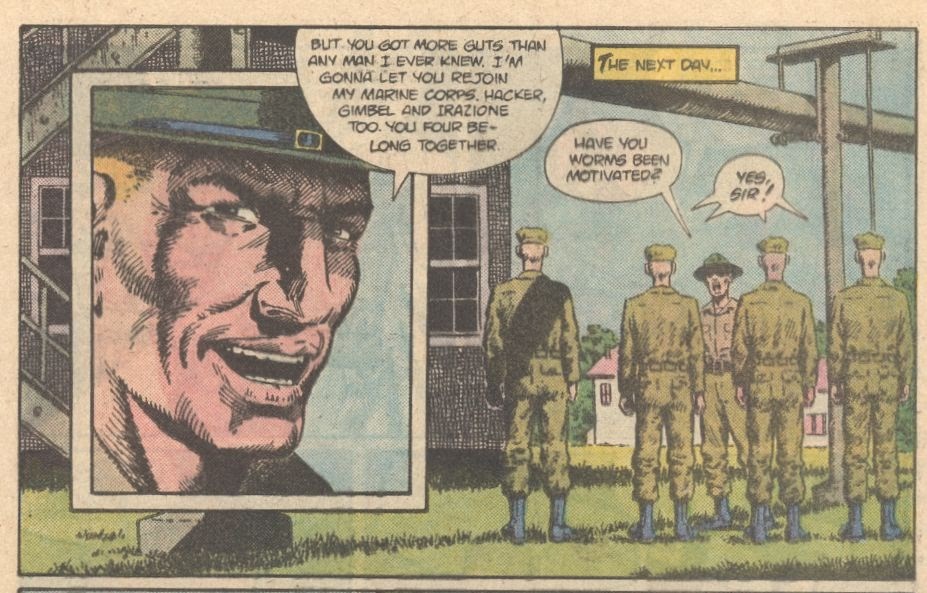 They are returned to their recruit platoons to continue boot camp. They move to the rifle range, where Sanduski proves an excellent shot. When it comes time to qualify, he set the range record.... 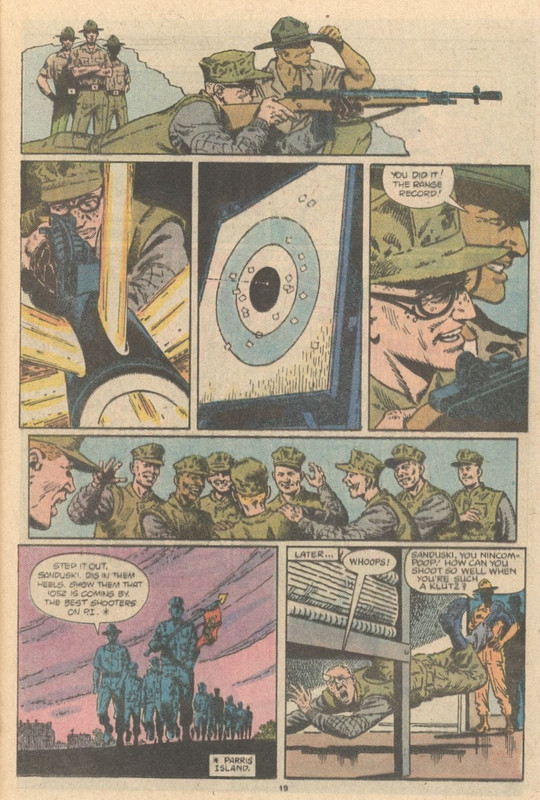 Sanduski earns the respect of the DIs and his fellow recruits and is given the honor of carrying the platoon guidon (penant, signifying the platoon and used as a rallying standard for them, traditionally). He is still a klutz, but he is an expert marksman and he makes it to Graduation Day and becomes a United States Marine. 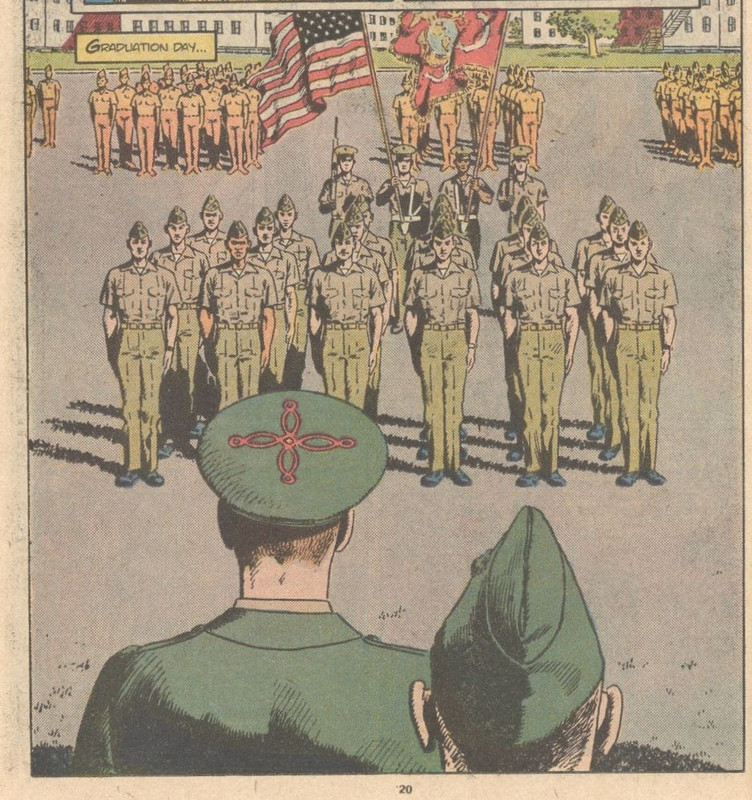 This is less about the Vietnam experience than it is about what it takes to be a marine, the best of the best (according to them and few will dispute that, without losing some teeth) The stakes were high for recruits, as they would most likely be headed to Vietnam and they knew that. Not everyone volunteered for the Marines, in this era, as can be seen in the film, The Boys in Company C. That was R Lee Ermey you saw there. He also appeared in Apocalypse Now, then Full Metal Jacket.... Ermey served 14 months in Vietnam, with Marine Wing Support Group 17, as well as in Okinawa, before being medically discharged. He became a technical advisor to film companies, starting with The Boys in Company C and branched out into full time acting. He was discharged at the rank of staff sergeant; but, was later made an honorary gunnery sergeant. He had been an actual Drill Instructor. With that, we leave Marvel Comics. This was not their end to depictions of Vietnam. I am not going to cover their other major piece, the insertion of Frank Castle, the Punisher, into The 'Nam, nor am I going to cover the later Punisher material from Garth Ennis, as it represents a fantasy of Vietnam, by people who were not there and use it for their own agendas. Chuck Dixon did the Nam story, which among other things has Castle chained up by his wrist, in a cave, as he is tortured by the VC, when he then somehow has the strength to wrap his legs around a guard's neck and snap it like a twig and escape, in a scenes that would make Rambo cry "Bulls@#$!" Ennis is a little better, but presents the typical Hollywood fantasy that everyone was stoned to the gills, in combat, that Marines were unmotivated screwups, and that only Frank Castle kept things together, while he was a one-man killing machine. That is Pure D horse@#$%! It is twisting a few incidents to fit an agenda, rather than telling a truth. Ennis did better by the WW2 generation and showed more empathy to German soldiers than US Marines, in Vietnam. It perpetuates debunked stereotypes and pretty much craps on the work of Doug Murray and Michael Palladino and their artistic collaborators in telling real experiences of the war, bot Hollywood BS, government propaganda or revisionism. It was Vietnam, warts and all. Dixon would have you believe in superhuman soldiers, which is fantasy, while Ennis would have you believe only negative stereotypes. In that aspect, it is no better than John Wayne's the Green Berets; it is propaganda, but with a negative connotation. Instead, I am moving on to a work with a legitimate critique of the war in Vietnam, with a definite point of view, but one founded in honesty, not commercialism. The next entry features Real War Stories, from Eclipse Comics and Joyce Babner, as we look at its depiction of the Draft resistance. |
|
|
|
Post by Prince Hal on Dec 30, 2023 12:29:09 GMT -5
codystarbuck, so glad you called Murray in that NYT headline in your detailed write-up about the "Hearts and Minds" graphic novel. The scene could have been done just as (a) poignantly (b) ironically (c) sardonically (d) whatever by finding an actual NYT front page/headline or even an amalgam based on contemporary headlines. The book may have been published pre-Internet (1990?), but there was microfilm, and it wouldn't have taken much for Murray to do a little research. No matter anyone's belief that the Times was anti-government, etc., it would NEVER have printed a headline so unbalanced in both design and inappropriateness. On the editorial page, maybe, but never top right on Page One. That kind of unforced error, like those you noted about ROTC, rankles me. It's clear -- at first, anyway -- that Murray thought he was trying to present a serious, somewhat realistic depiction of the war and the era, but the use of that headline was not only unrealistic, but unnecessary. The reader had already seen how "insane" the whole damned war was, let alone the madness of the personal tragedy Murray included in his story. (Strained and melodramatic, but the usual kind of episode we see in this kind of war story.) A modicum of research would have rescued the scene from cliché. Oh, one more thing... the title phrase from LBJ about winning the Vietnamese people's hearts and minds is doubly ironic. It was probably the Tet Offensive that prompted American hearts and minds to begin to change; Tet was the start of the up-close coverage of the war and its transmission to living rooms on television night after night. Then My Lai happened in March of '68, with the news breaking in September, obscuring most coverage of the thousands of civilian deaths in Hue that had been attributed to the PAVN and the VC. Our involvement lasted another seven bloody years, but it can be argued that the snowball of opposition began rolling down the hill with Tet.
|
|
|
|
Post by codystarbuck on Dec 30, 2023 15:43:18 GMT -5
codystarbuck , so glad you called Murray in that NYT headline in your detailed write-up about the "Hearts and Minds" graphic novel. The scene could have been done just as (a) poignantly (b) ironically (c) sardonically (d) whatever by finding an actual NYT front page/headline or even an amalgam based on contemporary headlines. The book may have been published pre-Internet (1990?), but there was microfilm, and it wouldn't have taken much for Murray to do a little research. No matter anyone's belief that the Times was anti-government, etc., it would NEVER have printed a headline so unbalanced in both design and inappropriateness. On the editorial page, maybe, but never top right on Page One. That kind of unforced error, like those you noted about ROTC, rankles me. It's clear -- at first, anyway -- that Murray thought he was trying to present a serious, somewhat realistic depiction of the war and the era, but the use of that headline was not only unrealistic, but unnecessary. The reader had already seen how "insane" the whole damned war was, let alone the madness of the personal tragedy Murray included in his story. (Strained and melodramatic, but the usual kind of episode we see in this kind of war story.) A modicum of research would have rescued the scene from cliché. Oh, one more thing... the title phrase from LBJ about winning the Vietnamese people's hearts and minds is doubly ironic. It was probably the Tet Offensive that prompted American hearts and minds to begin to change; Tet was the start of the up-close coverage of the war and its transmission to living rooms on television night after night. Then My Lai happened in March of '68, with the news breaking in September, obscuring most coverage of the thousands of civilian deaths in Hue that had been attributed to the PAVN and the VC. Our involvement lasted another seven bloody years, but it can be argued that the snowball of opposition began rolling down the hill with Tet. Murray definitely has a low opinion of journalists covering the war and that is a thread that seems common among a large section of the veteran community. It is easy to understand why when you see some of the reporting from the era, which sensationalizes things, stages things, or presents things with a deep ignorance or just lazy attitude to fact checking. It isn't helped by the propaganda in Stars & Stripes, as well as editorial control of the Armed forces broadcasts. Good Morning Vietnam paints a rather fictional picture of the latter, according to some of the things I have read, from people who were involved in military broadcasts, on radio and television (the Army had it's own tv news broadcasts, from Saigon). However, such things could often be transformed in the editing. There were tons of stories of journalists who never set foot outside of bars and brothels, in Saigon, yet were writing or recording stories about events in Pleiku or An Loc, or somewhere else. Others were embedded with soldiers and gave more nuanced reports, or flat out lost objectivity. Joseph Galloway, who was a WW2 vet, was a UPI correspondent and bureau chief, in Vietnam and lived and went on patrols with troops. He was there, alongside the First Cav, at the Battle of the Ia Drang Valley, where he tossed aside neutrality and put himself under fire to help rescue wounded soldiers, for which the Army awarded him a Bronze Star, with V for Valor device (representing heroisim, under fire). At the time of the series, at least, I don't think Murray could separate the good journalism from the bad and I think he and others pointed to the bad journalism as a source for the resentment they received from civilians, when they returned home. It is understandable, from their point of view, to see the media manipulating public opinion to sell a story, causing them to be cast as vicious killers, or mindless robots under control of the government and military. Veterans of that war were ill-treated, so some prejudices are understandable, from their POV, if not necessarily justifiable. I developed a pretty low opinion of modern journalism, in general, during the Gulf War; but, mostly due to the obvious laziness and their over-reliance on soundbites, instead of in-depth reporting. The quality of reporting seriously degenerated in the ensuing 20 years. I gave up on broadcast news from the networks or CNN and spend more time getting my news from either print/online sources (reputable news agencies, not some wannabe website) or from broadcast sources who do more than report headlines and some quick images. The next installment will definitely be looking at the opposite end of the spectrum, from the anti-war movement and draft resistance community. After that, I will be looking at Don Lomax's Vietnam Journal, which has a more nuanced look at things and also features a wider array of Vietnam units, with a mixture of Army, Marines, Special Forces, air units and even CIA programs, without the restraint of the Comics Code and from another veteran of the war, with a grounding in the Undergound scene (or an "undergrounding," if you prefer). Protesters get a little bit of criticism there; but, it is a fairly honest one and a bit less generalized. This is one of the most interesting personal testimonies I have seen, relating to the war..... William Earhardt, a Marine (1st Battalion, 1st Marine regiment, 1967-68 in Vietnam), Purple Heart and Navy Combat Medal) and later a poet and author. |
|
|
|
Post by codystarbuck on Dec 30, 2023 16:21:01 GMT -5
ps In viewing the above, you can see how some soldiers might have a prejudice against journalists for showing what they were doing, without the context they had in their heads. Ehrhardt has done a lot of soul searching about what he did and saw, while others processed it differently and turned it into resentment, for blaming them for the policies of the US government and its agents, or for not giving them the support they felt they needed to actually achieve something, or just putting them there, ripping them from their stateside lives, dumping them in hell, then ripping them back home, with little or no support. The thing that bugs me, as a veteran, though a non-combatant, is that we still haven't learned those lessons, as can be seen in the veterans of the War on Terror, who are grappling with PTSD and physical scars, a media that mostly deals in sound bites, others who dug into some of the inhumane things that happen in war, especially with insurgents/terrorists and the suicide rate of said vets. Add to that, the repeated failure to fund the VA system to pay back those who served and sacrificed, rather than to stick them in a corner somewhere, in the dark, until a photo op is needed and some politician can pretend they actually care. The US isn't alone in this, as you see it in other societies, who have been involved in military conflicts. After the war, they don't want to see the soldiers who fought it, especially if they are damaged by it, so they can forget and get on with their lives. The thing is, it is easier to forget when they didn't experience the horror and even participate in it.
I've been reading twin books, centered around the battle for France, with the Normandy landings. The first is Antony Beevor's D-Day, the Battle for Normandy, and the second is Operation Jedburgh: D-Day and America's First Shadow War, by Colin Beavan. Both go beyond the kinds of histories you used to see, about battles and strategies, with tales of individual heroism. They cover both sides well and also how the French people were affected, the political side of things and the atrocities committed in the name of freedom. Beevor details the immense number of casualties, on all sides, as the Allies try to take the beaches and then break out into the countryside. There is talk of whole cities and villages flattened by heavy bombing and artillery barrages, before tanks and infantry go in, of fighter-bombers strafing and destroying columns of tanks and infantry, trying to reinforce the defenders, of the Resistance being organized by the Jedburgh teams to direct sabotage and delaying tactics and the reprisals that resulted from their actions. Villages burnt and the citizens murdered, children shot, people hung from lampposts. Tales of soldiers with their throats cut, after being captured. Prisoners being shot because they don't have time to deal with them, watching helplessly as teenage boy Maquis are cut down by trained soldiers, but trying to help them will only result in your own death. Beevor is an ex-British soldier, serving with an armored unit, in West Germany, in the 70s and Beavan is the grandson of a CIA officer. Both talked to veterans and others, read the diaries and official histories, the personal accounts and interviewed survivors. Both make the "just war" seem just as nasty as what came later and also bring you more detail about why the veterans don't want to talk about the things they did.
You can see how you would resent journalists who didn't live through your experiences present a portion of that, without having the space or knowledge to give it full context. You can also see how it would create resentment for forcing the soldier to relive that and expose that to family and others, who may now look at you in a different light. Vietnam exposed a lot of dirty secrets of previous wars and did it on the 6 O'Clock News, to the entire nation and world.
|
|
|
|
Post by zaku on Dec 31, 2023 4:47:05 GMT -5
I don't know if it might interest you but the Vietnam War is an important element in this story.   It's a miniseries that imagines how Spider-Man's life would have unfolded if he had aged in real time, from 1962 to the present day. Every issue represents a decade. This is the first issue's synopsis from Marvel wiki |
|
|
|
Post by foxley on Dec 31, 2023 6:35:24 GMT -5
I bought the entire run of Semper Fi from a back issue bin for 50 cents an issue. I suspect the book had even less appeal in Australia than it did in the US. (Australia doesn't have marines. Both the army and the navy have troops trained in amphibious operations, but no dedicated separate service).
However, I found it interesting because it had stories set during some lesser known episodes of US military operations, such as the Nicaraguan campaign of the 1920s, which I imagine is not well-known even in the US.
|
|
|
|
Post by codystarbuck on Dec 31, 2023 13:53:52 GMT -5
I bought the entire run of Semper Fi from a back issue bin for 50 cents an issue. I suspect the book had even less appeal in Australia than it did in the US. (Australia doesn't have marines. Both the army and the navy have troops trained in amphibious operations, but no dedicated separate service). However, I found it interesting because it had stories set during some lesser known episodes of US military operations, such as the Nicaraguan campaign of the 1920s, which I imagine is not well-known even in the US. It's not, especially in the 80s, when the Reagan Administration was arming the Contras. The US government put Samosa in power and it was his brutal dictatorship that was ousted by the Sandinistas. The Contras were, basically, Samosa loyalists, meaning as bad, if not worse, than any crimes of the Sandinista government, under Daniel Ortega. An interesting figure from that period is General Smedley Butler. He served and commanded troops in that era, including the Philippine Insurrection, the Veracruz intervention, Haiti, Honduras, Nicaragua and World War I. He won two Medals of Honor (Veracruz and Haiti). He became an outspoken opponent of US business interests manipulating US foreign policy and supported the Bonus Army, a group of veterans who marched on Washington, seeking an earlier redemption of their bonus certificates, which wouldn't reach maturity until 1945, to help relieve their suffering during the Great Depression. Federal troops were used to disperse the veterans, under command of General Douglas MacArthur (including cavalry troops under General George S Patton). Butler gave a series of anti-war lectures, saying they were being perpetuated by banking and business interests, for their own gains and decried the Roosevelt Administration's ties with business interests. He wrote a book, titled War is a Racket!, in which he described his experiences in Latin America and called himself "hired muscle" for various interests, including New York Banks, United Fruit Company and Standard Oil. He talked about spending more time dealing with New York bankers than administering Nicaragua, when he was military governor. He was later approach by a Right Wing cabal of businessmen to plan and launch a military coup of the Roosevelt Administration. He refused and reported the conspiracy to the government, which was publicly dismissed, but privately found credible evidence of such a plot. Butler is featured in a segment, drawn by Wayne Vansant and written by Joyce Babner, using Butler's own words, to illustrate how the military and the foreign policy of the US has been manipulated by business interests, for generations, in Eclipse Comics Real War Stories #2. I will be talking about the first issue, next, which gets into the Draft Resistance organizations and others who sought to protect servicemember rights. John Severin draws the story of the Boxer Rebellion Marines, which is equally little known in the general populace. The whole period, from the end of the Civil War to the Great Depression is barely discussed in the average history class, with The Spanish-American War and World War I getting the lion's share of discussion. My high school discussed some elements, like the Grange Movement, but it was mostly the military stuff, plus US expansionism, leading to the Spanish-American War, a bit about the Banana Wars, and a bit about Teddy Roosevelt and the White Fleet. However, we tended to zip through that stuff. Severin loved drawing the China Marine stuff and anything that smacked of the Western. Chuck Dixon touched a little on some of that, in the Sky Wolf back-up stories, in Eclipse's Airboy, when he did a story where Sky Wolf's father flew an airplane, in support of Pancho Villa. That is the thing about the US Marine Corps. because they work in conjunction with the US Navy, they have been America's global response force, since their inception. They have had more combat experience than any other part of the military, across the history of the United States, as they were the ones sent in to deal with the Barbary Pirates, into Mexico and Latin America, the Caribbean, the Philippines, China, North Africa (see the film The Wind and the Lion, except Candice Bergen's character was actually a man), WW I & II, Korea and Vietnam, as well as peacekeeping in Lebanon, the Gulf War and the War on Terror. That is part of why they view themselves as an elite force. Those historical stories were great, especially the art; but, Michael Palladino never really mastered how to use dialogue effectively, in comics. It seemed he was far better at plot. I think that was part of what hurt it; plus, it was an anthology and kind of lacked focus, despite the Whittier family being central to things, over the generations. The Revolutionary War feature, drawn by Sam Glanzman is another strong segment and the longest duration of any feature in the series. Glanzman did his research and you get a mixture of frontier and shipboard Marine experiences. |
|
|
|
Post by codystarbuck on Jan 3, 2024 21:19:49 GMT -5
One of the central issues to the Vietnam War was "The Draft." Unlike the modern military, the Vietnam Era military included draftees, not just enlisted soldiers, sailors and airmen. This was nothing new, conscription goes back to the Revolutionary War, as colonial militia were drafted to serve in specific campaigns. During the War of 1812, President Madison attempted to introduce legislation to draft 40,000 men into the Armed Forces, but the measure was defeated, largely due to rhetoric from Congressman Daniel Webster (he of The Devil and Daniel Webster fame). Conscription on a national basis was employed during the Civil War, on both sides. There was resistance to the practice, resulting in riots. You could actually get out of service by paying someone to substitute for you and there were bounties and bonuses for enlistment. There are stories of Irish immigrants being essentially conscripted as they came off the boat. In the South, conscription officers and judges were notorious for playing favorites when determining draft exemptions, as those of the upper classes were less likely to be conscripted than the poorer. In 1917, following the declaration of war against Germany, the Selective Service Act of 1917 was instituted, setting up the Selective Service system, aka "The Draft." All men between the ages of 21 and 30 were required to enlist for military service, for a period of 12 months. This was in the form of registration. Then, they were placed in one of 5 classifications, with Class 1 being "drafted" for active duty military service, with others deferred or dismissed, due to medical reasons or humanitarian. Selective Service ended in 1920. The experiences of World War I led many to push for US neutrality in further European conflicts, including World War 2, in 1939. However, the Roosevelt Administration believed that the US was unlikely to avoid the war and was concerned about German domination of Europe and the fate of Great Britain, its largest trading partner. Several efforts were made to work around neutrality laws, such as the Lend Lease Act, which provided material support as a temporary loan, not a sale of arms. In 1940, The Selective Training and Service act of 1940 was passed, establishing the first "peacetime" draft. All men, between the ages of 18 and 64, were required to register with the Selective Service. Those conscripted were done so for a period of 12 months. This was extended to 18 months, in 1941, and then for the duration of the war, in early 1942, plus 6 months in the organized reserves, after the war. In other words, those drafted into the Armed Forces in WW2, after Pearl harbor, served until the end of the war, barring death, serious injury or humanitarian discharge. In 1945, a bill was introduced to draft female nurses, but this led to intense debate and was not passed, then the end of the war brought the end of the crises for medical personnel. The 1940 act was terminated in 1947. However, a year later, a new Selective Service Act was instituted, which would last through 1969. All men, ages 18-25, were required to register for Selective Service. Periods of service were set for 12 months active duty of 36 months in the organized returns, with a maximum set at 5 years continuous service. Few were conscripted, until the outbreak of hostilities in Korea. In 1951, the draft was amended with the Universal Military Training and Service Act, which extended the service period to 24 months. This remained in force, via extension, through the Vietnam Era. In 1963, President Kennedy signed an executive order granting exemption status to married men between 18-25, though President Johnson rescinded it and replaced it with an exemption only for married men, with children. Students were deferred, while in college, but, became eligible for draft upon completion of their degree or at the age of 24. In 1969, President Nixon signed an amendment that set up a random lottery system, for the draft. Conscription has always been a controversial subject, especially in a "free society", because it compels men to "take up arms, against their will." The problem is and was, there is no provision in the Constitution that prevents the government from introducing conscription. The Second Amendment even includes the text, " A well regulated Militia, being necessary to the security of a free State, the right of the people to keep and bear Arms, shall not be infringed." It basically says that a militia was necessary for the security of the nation and then provides the right to keep and bare arms as a Constitutional protection for that purpose. The Third Amendment sets forth the prohibition against quartering soldiers in a private home, without the consent of the owner, in peacetime, or as proscribed by law, during war. Neither have ever been ruled to state that American citizens could not be drafted into the military. However, the Vietnam Era draft had a further complication, conscription began at age 18, but the voting age was 21. Young men, who had no say in electing government representatives and leadership, were being compelled to perform military service, in a combat zone, without a formal declaration of war. This was a major element that fueled the student protests of the war and ultimately led to the passing of the 26th Amendment, in 1971, lowering the voting age to 18. You can can make many conclusions about the fact that the US drawdown in Vietnam began in 1972, when 18 year-olds would be voting in their first national election. Since the creation of conscription, there has been resistance. There have been demonstrations, riots, registering as conscientious objectors, refusal to register for Selective Service and outright evasion, by fleeing from authority, often including leaving the country. During Vietnam, many draft resistors elected to flee the country to Canada, where civilians had created a sort of Underground Railroad to aid US citizens in entering the country. There were also desertions by active duty personnel, who walked away from duty stations and hid themselves from authority. Some applied for sanctuary in foreign embassies and were granted such status. During the war, a regular form of protest was the burning of draft cards, which was a crime, under the law. Those were just the protests, though. There was also a game of using the system against itself, by gaining deferments via fraudulent means, or legally, through influential contacts. During his election campaign, President Clinton was painted by the Republicans as a "draft dodger," despite the fact that he had a legal deferment, as a student. President George W Bush had a deferment, via service in the Texas Air Guard, though records later showed him being released from duty on multiple occasions for political work, for his father, as well as being absent from required training periods, with no official release. Much of this was made an issue by the Democratic Party, in the 2000 Election. It was far easier for the wealthy and politically connected to gain a "legal" deferment. Also, economic status meant attending college, where you could have a student deferment, for the duration of study, or until age 24. Thus, the draft became an economic punishment to those who could not afford college and had no political benefactors, especially those in minority groups, as we saw earlier, when discussion Julian Bond and the anti-draft comic he helped produce. That long winded intro sets up our next feature, Real War Stories, from Eclipse Comics.   Now, some further background; but, I will try to keep it brief. Eclipse Comics was found by Jan and Dean Mullaney, who had a definite liberal philosophy. Their comics were edited by cat yronwode, who was married to Dean and shared, if not exceeded his views. Eclipse books often contained editorials and even PSA pages, relating to liberal causes, such as education about Supreme Court rulings protecting the right of peaceful protest in schools, or the dangers of nuclear strikes, with the stated effectiveness of the Space Defensive Initiative's (Ronal Reagan's "Star Wars" program) proposed weapons platforms. Chuck Dixon and cat found themselves increasingly at odds over the course of stories in Airboy, particularly stories set in Afghanistan, during the Soviet Occupation. In fact, the Soviet Invasion of Afghanistan had led to President Jimmy Carter, in 1980, in reinstituting Selective Service Registration. Selective Service was abolished, in 1975, by President Ford, whose own son, Stephen, had never registered with Selective Service. The new requirement stated that all males, born ofter 1960, must register at age 18. The Selective Service Administration sent out notices, on your 18th birthday, requiring you to register, within a certain time frame (I don't recall the exact period. I did not register. Initially. You see, I received a Navy ROTC Scholarship to attend the Univ of Illinois. However, I was 17, when I graduated high school and received the scholarship, since my birthday is in November. My parents did have to sign a waiver for me to begin ROTC. We were sworn in on our first day of orientation. So, I was, technically, in the Naval Reserves, as a midshipman. I thought that meant I didn't need to register with Selective Service, when I turned 18, 3 months later. Imagine my surprise, later, when I saw a notice to report to the administrative office of by NROTC Unit. The senior chief yeoman (who handled personnel records for officers) told me that they had been alerted that I was not registered with Selective Service. He seemed stunned. I was equally stunned. I told him that I thought that wasn't a requirement, since I was already serving in the reserves, as a midshipman. He explained that it was still required, because of the usual bureaucratic nonsense. So, I filled out the registration, which could eventually seeme drafted into the military, in which I was already serving. Joseph Heller didn't exaggerate much of the insanity of the military and government. Anyway, most people complied with Selective Service. There were some who refused, which will factor into this discussion, in a bit. Getting back to Real War Stories, the first issue was published in July 1987. I actually missed it, because I was coming back from my summer training cruise, in San Diego, and wasn't near a comic shop, until I got back home and missed it, on the stands (if the local shop ever got it...Eclipse didn't always get great retailer support upon release of an issue, depending on the series). The issue is edited by Joyce Babner, wife of Harvey Pekar, who was working with the Central Committee for Conscientious Objectors (CCCO), a non-profit organization that aided conscientious objectors, with advice and legal aid, and had done so, since 1948. They were very active during the Vietnam War, helping draft resistors and actual active duty personnel obtain discharges or protect their rights as COs. For instance, in 1951, they successfully pressured the US Army in stopping the assignment of COs to mine laying duties. In the Vietnam Era, they had offices in several major cities, produced education booklets for draft resistance and provided "draft counselors," to guide citizens through the legalities of resisting the draft or filing as a conscientious objector. With the reinstatement of Selective Service, in 1980, and the increasing use of the military, by the Reagan Administration, especially in Latin America, the CCCO was looking to produce a pamphlet for a new generation. Joyce Babner got involved, as she felt a comic book could be more effective than a standard pamphlet. The main focus of the issue is to provide parallels to the Vietnam War and the Administrations use of the military in support of theContras, in Nicaragua, and in supporting the governments of El Salvador and Honduras, as well as Guatemala, where the government (placed in power when the US government, via the CIA, implemented a coup of the democratically elected Arbenz government) was engaged in hostilities with the indigenous population in rural areas. It takes the form of an anthology, with varying stories relating personal experiences in the military, US history, and outright propaganda, in some cases....or, at least, arguable claims. The opening story is about an African-American CO, named Tim Merrill, who had actually enlisted in the US Navy. He did so, in the 1970s, out of boredom and in a search for self-discipline and marketable job skills. He avoided the Army and Marines, because he didn't want to kill. He hoped to get into electronics, in the Navy, but the recruiter only talked of menial jobs, like mess cook, which had traditionally been the only position open to minorities, in the Navy, before desegregation, in 1948. He pushed back and the recruiter offered up sonar technician and Merrill entered under the delayed entry program. He was assigned to submarines, but eventually came to realize that his job entailed identifying targets which were then used to launch missiles or torpedoes and that he stood security duty with the nuclear warheads. He began educating himself and eventually registered as a conscientious objector. he included an account of discovering a sailor who had been subjected to a hazing, referred to as "greasing," where a grease gun (an actual one, not the M3 submachine gun) is inserted into the victim's rectum and grease is pushed out the nozzle. He claimed it was a common thing on naval vessels, though I had never heard of such things, during my tenure, which was nearly a decade later. I do know that the 1970s were a very turbulent time, for the US Navy, as there were leadership problems and racial problems, in the wake of Vietnam. Enlistments were down and the prestige of the Navy suffered greatly after Vietnam. Drug use was heavy. There were other hazing rituals with elements of violence, such as the Shellback Initiation, when crossing the Equator, where part of it included running a gauntlet of people armed with lengths of firehose, to beat initiates. This portion was outlawed, by my time, but other dangerous things were still allowed. Grenada was the real turning point for Merrill, leading to his registration and eventual departure from the military. Essentially, the story serves to paint a negative picture of the US Navy and the Armed Services, in general. I don't dispute Merrill's experiences, as I have heard of enough things like that and know that racial discrimination were serious problems in that period and even in my time.  Another story features a woman's experience in the US Army, also post-Vietnam. Nancy was the daughter of a Marine veteran, who supported the war in Vietnam and a mother who opposed it. They watched the evening news, with reports from Vietnam, where she saw images of bodybags. She participated in student protests, in her youth. She dreamed of being a concert pianist, but her parents didn't feel it was a proper job and she was sent to school to study other things. She hated school and dropped out of college after 6 months and got a job, at a supermarket. She was bothered by images of protestors verbally attacking returning soldiers, arguing that they didn't have a choice in the war. She argued with friends and then went to an Army recruiting office to get information and ended up enlisting, to study and play music.... 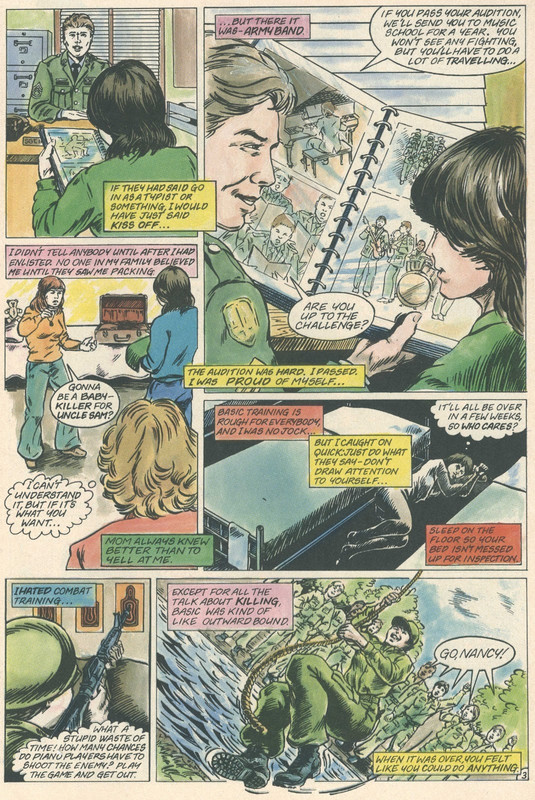 Nancy actually gets to study music, then travel around performing, until personnel shortages take away her job of playing music and push her into becoming an MP. She was the only woman with 800 men, in training and was used as a negative example, repeatedly. She was sexually harassed, but didn't give in. She got through training, but faced further discrimination and harassment, in her duties. She was forced to undergo airborne training, where she had problems with the physicality. She was ostracized within her unit and then declared a lesbian and investigated. She was stationed at Ft Bragg, where the only 3 women she knew were married to officers. There were no facilities for a female soldier and she had to find her own off base quarters. As a female MP, she was often required to deal with rape cases, which were usually enlisted women, most often raped by other service members. MPs were often dealing with domestic violence situations and she also had to undergo combat training. She left the military, but remarked that every female who came into the MP unit was subjected to similar treatment, including investigation as a lesbian. She later appeared on the Phil Donahue Show, in the audience, in a program with a satellite link to women in the Soviet Union, where they asked quetions of one another. She stood up and asked how the Soviet women felt about their sons, brothers and husbands being in Afghanistan and reiterated how they felt, when they first answered with political justifications. That segment was edited out of the program. Again, this presents a negative picture of the military, though one that is completely justified, by my own observations and some memoirs I have read, includin In The Men's House, by Capt Carol Barkalow. Barkalow was part of the first class of women cadets, at West Point and related her experiences there and after. Se tells of constant harassment, including a saber stuck through an anonymous note, telling a cadet that women didn't belong in the Army, which was pinned to her bed. She also remarked of advisors from Revlon being brought into to teach the soon to be commissioned cadets to appear more feminine, with make-up classes. The women, in unison, rebelled and took their grievances to the commandant and the practice was dropped. She continued to face harassment and discrimination in the Army, despite rising to command a missile battery, in Germany. She participated in bodybuilding competitions and later found that a picture of her, posing in a bikini, was circulating the base. Just recently, a ruling came down, removing rape cases and several other crimes from military jurisdiction, because of how the military has handled such cases. The incidents of rape and harassment of female servicemembers continues to be a problem, to this day. During my time in the military, the Tailhook Incident hammered home problems with the military's handling of sexual harassment, as did several cases involving drill instructors and female recruits, as well as non-coms and enlisted females. I served temporary duty aboard a destroyer tender, one of the few ships on which women could serve, in that period. They had encountered several problems with fraternization between officer and enlisted and non-com and junior enlisted. They had only recently had a warrant officer go down for it. Later, after I left, a female ensign was undergoing disciplinary procedures after an affair with her chief was exposed, reversing the situation. That was the other extreme and far rarer, as men were more likely to be in positions of authority and use that to their advantage. Steve Leialoha tells a personal tale of alternative service, as a conscientious objector, where he served in the California Ecology Corps, a program started by Governor Ronald Reagan. He spent time working on maintaining state park facilities and fighting forest fires... 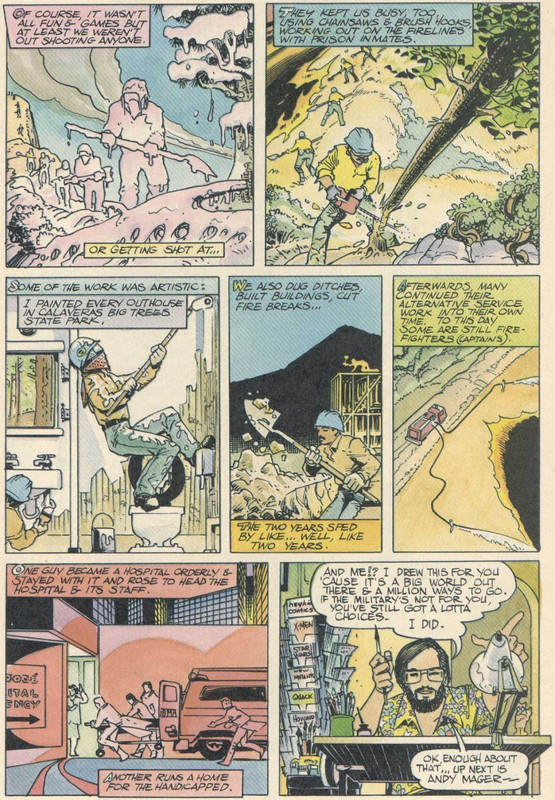 Steve Englehart was also a conscientious objector, who spent time on active duty, before obtaining his discharge. Another story speaks of the experience of Andy Mager, who refused to register with Selective Service, when reintroduced and his refusal, in court. he was one of 20 people prosecuted for failure to register, despite statistics that hundreds of thousands had failed to register. 18 of those 20 prosecuted had lodged protests about the system and the law.  The ending story features accounts of the atrocities in El Salvador, committed by government death squads. This was to give background and to educate about the government that was being supported by the Reagan Administration. There were also protests by nuns at the School of the Americas, at Ft Bragg, which trained US and foreign soldiers and police in counter-insurgency tactics, including torture. The nuns belong to an order which had members massacred in El Salvador, by the government death squads. This piece is the most overt in comparing the Reagan Administration's Latin America policies to the experiences of the Vietnam War. 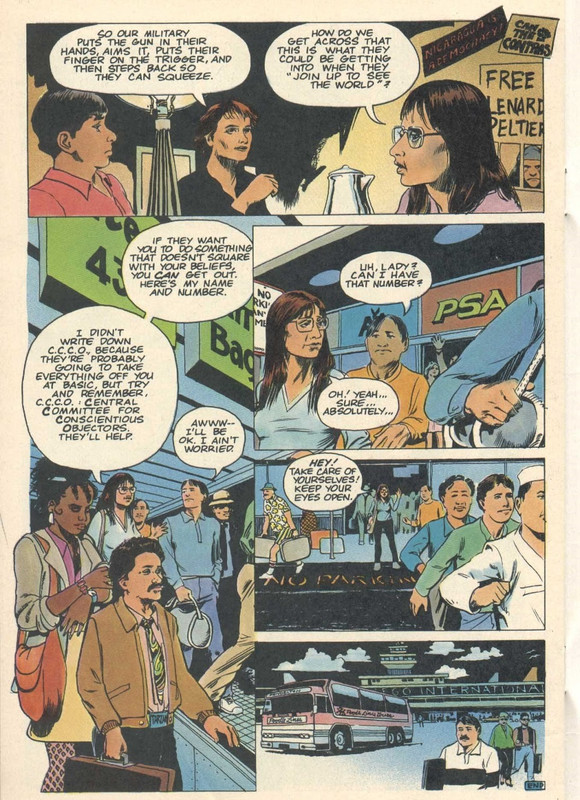 There is a map of then-hot wars and US military deployments around the world, illustrating just how far abroad US service members were serving, despite not being engaged in a hot war. Much has changed since then, but 9/11 altered things far more than even the Gulf War did. The really notable piece of the comic, for my money, is Alan Moore's story, based on the experiences of WD Ehrhart, a writer, poet, scholar and veteran of the US Marine Corps, in Vietnam. Moore and artists Stan Woch and John Totleben tell Ehrhart's story, of growing up in Pennsylvania, the son of a minister. he was patriotic, decorating his bike for Memorial Day and he eventually enlisted in the Marines, in 1966, after graduation from high school. He served in a battalion intelligence section, which meant he was involved in the handling of prisoners and "detainees", held for interrogation. The story juxtaposes illustrations of his life in the US with his experiences in Vietnam. You see his bike decorated, then a scene at boot camp, of drill instructors making racist statements and sexist remarks. Images of "duck and cover" drills in school juxtapose detainees, bound hand and foot, being thrown off of an APC, with no way to break their fall. The biggest image is of shooting an 8 year-old boy, about to hurl a grenade, probably given to him by a VC, without any real knowledge of what it would do. He also shows praying in church, contrasted with taking part in smashing up a Buddhist temple.... 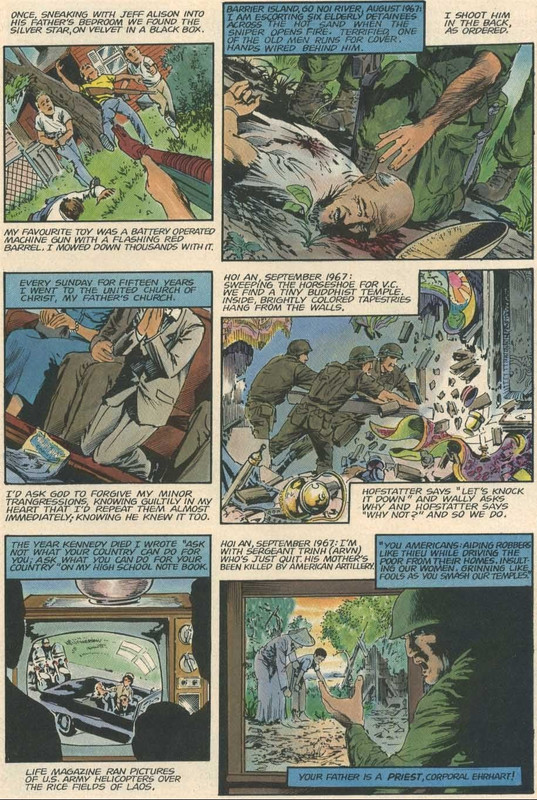 Earhart remarks of a Vietnamese soldier, who had been friendly, but denounces him and the Americans as worse than the VC, for supporting a corrupt government, treating the women like prostitutes, burning villages and destroying their land. When Ehrhart returns home, he finds himself ostracized. As a college student, he is the only veteran and the only people who engage him do so out of morbid curiosity. At a dance, women avoid him and he gets drunk and throws up in the toilet. He joins in protests in 1971, as Nixon expands the war and is attacked by police in riot gear, after they have sealed off the streets, despite ordering the protestors to disperse. They have nowhere to go and are attacked with nightsticks and tear gas. He recalls escorting villagers from their homes, as they are set on fire. Eventually, in 1985, he returned to Vietnam, where he is shown a water pump, made out of an old RPG launcher. He meets a woman who lost 5 sons in the war and when he asks who killed them, she points at him. He visits a pagoda temple, where a priest offers him an incense stick to say a prayer and bangs a bell to wake the spirits to hear it.  He also travels Nicaragua and Honduras and sees the similarities to Vietnam. This is by far the most powerful part of the comic, as it features the experiences of a veteran, before and after and draws direct parallels to the then-present. Ehrhart grew up like many of his generation, idolizing the country and the generation of soldiers who fought against fascism and military aggression, though oblivious to earlier acts of aggression by his own country. He enlists in the Marines to serve his country and arrives in Vietnam, expecting to be treated as a liberator, like soldiers in France and Holland, only to find he is hated and despised and comes to hate himself. He returns home to find that he is looked upon as an outcast and descends into alcohol. He rebuilds his life and shares his experiences, as he did with the 1983 PBS documentary Vietnam: A Television History, from which his interview above is used. He was one of the voices of the Vietnam War who conveyed the soldier's experience, which eventually reached an audience ready to listen. I have no evidence, but my suspicion is that this comic went largely unnoticed, in 1987. It didn't fit the climate and it was from a small company that was routinely ignored by retailers and comic fans, with particular exceptions in their line. It was defiantly liberal in a conservative period and it feels out of touch, more than a decade after the Vietnam War ended. That is kind of the point of it, though, as it illustrates how the lessons of Vietnam had been lost on government. It proposes that the Reagan Administration was following the same pattern of the Eisenhower, Kennedy, Johnson and Nixon Administrations, in Vietnam, by involving themselves in civil wars, propping up corrupt Right Wing governments and radicalizing the Left, doing the work of the Communists for them and preparing another generation for protracted wars in foreign lands. Where it missed the mark was in focusing on Latin America, which, to be fair, did seem to be the next battleground for US forces. This was especially hammered home with the War on Drugs, which provided aid and advisors to fight the cocaine cartels, while journalists were trying to report a story of CIA involvement in trafficking drugs from Latin America, to fund operations with the Contras and other forces in Latin America. The real war, would prove to be in the Middle East and it was my war. I joined the US Navy to go to college, which was about the only avenue available to me, since the Reagan Administration had pretty much removed grant programs from the table and replaced them with Guaranteed Student Loan programs. If you wanted to go to college, you had to be rich, get a rare scholarship, go into debt for years to come, or join the military and get your degree through either a commissioning program (academy or ROTC) or the Montgomery GI Bill (or National Guard or Reserves). My father was a teacher in a rural school district, my mother a real estate agent in a depressed market. I qualified for loans, but a guidance counselor showed me a brochure about the Navy program. Full tuition, books and fees, plus $100 month stipend. That covered everything but room and board and I applied and was accepted. My war was as much a result of Vietnam as it was the geo-political climate and the American dependence on oil. It didn't actually feel like we liberated Kuwait, when the citizens of that country were given no say in who governs them, afterwards. We also left Hussein in power, in Iraq, and set up the next war to occur. I felt as disillusioned as my predecessors in Vietnam. Issue #2 was done in 1991, in conjunction with Citizen Soldier, a non-profit group that represented GIs and veterans in legal issues and battling organizational violation of rights. They represented veterans dealing with the effects of exposure to Agent Orange, as well as military nuclear tests, training accidents, incidents of racism and homophobia, and other violations of rights and reckless endangerment. The issue largely focuses on deaths in the military to circumstances other than combat, including training accidents and coverups. There is a story that refers to Navy diver training and an exercise, called "Sharks and Daisies." The exercise involved the divers having their hands and feet secured (a regular part of training, to learn to swim with all of their body, in case hands and feet are incapacitated), where instructors would strike them, when they popped above the surface, like a human whack-a-mole game. There had been multiple injuries and some deaths due to this training, which was a national news item, at the time of publication. It was a scandal within the Navy, while I was on active duty. Other accidents and cover ups of accidents are covered, including a tale by Mike Barr, about his own father, who was killed in a training accident, before he was born. There is a piece about Gen Smedley Butler, a Marine general and twice awarded the Medal of Honor, who had served in America's various incursions into Latin America, as well as the Spanish-American War and WW1. He wrote a book, War is a Racket, where he detailed how those incursions were carried out under the lobbying of business interests.... 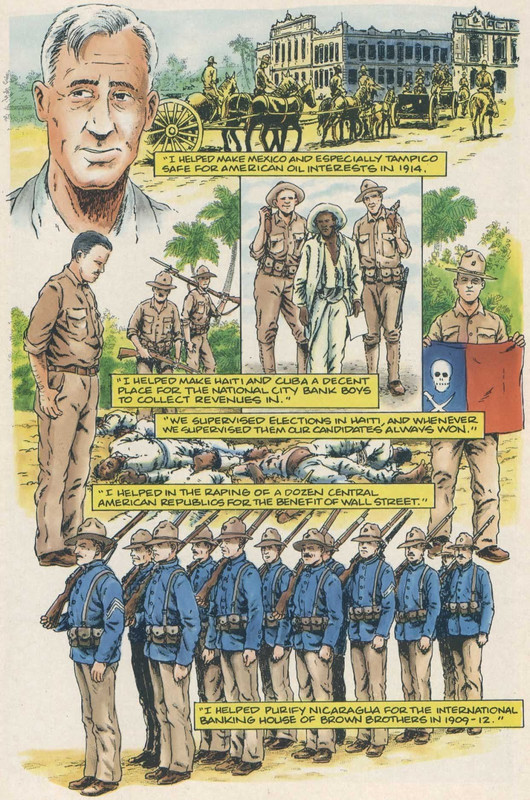 It includes text from speeches in support of veterans and how they were treated after, particularly the Bonus Army and how veterans should work to protect future generations from war, at the behest of special interests. This is juxtaposed with images about the VA denying treatment to vets suffering from exposure to Agent Orange as well as having to justify injuries suffered during service... 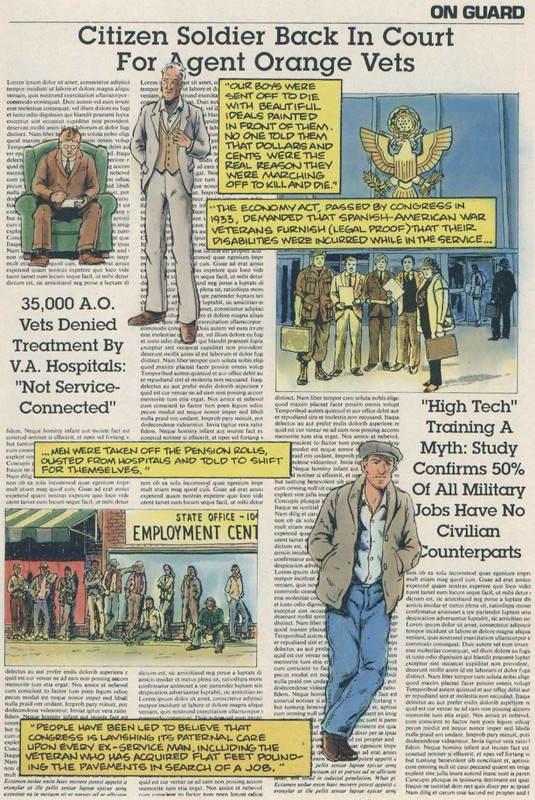 Kim Yale writes a piece about the work of Citizen Soldier, in providing legal counsel to servicemembers and veterans, with Agent Orange a major focus, as well as deceptive recruiter practices and the lack of actual marketable job skill training in the military. They present statistics of actual jobs vs civilian use for such skills. Other pieces talk about pirate newspapers circulated on bases during Vietnam, critical of the handling of the war, despite potential military charges they faced for publishing and distributing those newspapers. One piece, told as an Alice in Wonderland story, talks about how laws are in place to protect the government from service members bringing suit against the government for injuries incurred in the military or by government contractors. These laws were used to fight claims for exposure to Agent Orange, but even less well known is the plight of veterans exposed to radiation, in Atomic Battlefield tests, in 1957, as well as the Bikini Atoll test and other work. I went to college with a woman whose father was a physicist and involved in some of these experiments and was suffering from leukemia, but the government would not recognize the claim of injury during service. Agent Orange became a major issue in the late 70s and 80s, as service members developed cancers and other ailments and had a high number of children born with birth defects. Tod Ensign, the founder of Citizen Soldier, brought a class action suit against the government, related to Agent Orange. In 1984, several chemical companies involved in the manufacture of Agent Orange settled a class action suit, just before jury selection was to begin for a civil trial, paying $180 million in compensation. However, the money was miniscule, per veteran, and payments spread over 10 years. In 1991, The Agent Orange Act the power to declare certain conditions presumptive to exposure to Agent Orange and to provide care to veterans. However, this has not been universally applied and Air Force veterans of Operation Ranch Hand (which disbursed the defoliant) were denied claims, since they were not on the ground. This changed in 2015. So, with the first issue, we focus more on the parallels of Vietnam and the Reagan Administration's military operations in Latin America, with WD Ehrhart's story, through Alan Moore, being the strongest center piece and most direct discussion of Vietnam. The rest serves to reinforce the parallels and negative aspects of military service. Again, this issue was before the Gulf War. At the time, Democrats controlled Congress and fought the administration's efforts in Latin America, to a certain extent, so outright military intervention did not occur, though US troops were suddenly deployed to Honduras, when a border crisis erupted, as Nicaragua attacked Contra bases, along the border with Honduras. Honduras had been a staging ground for the Contras, with the US government providing military aid to the government. troops were deployed to prop up the Honduran military against potential invasion by Nicaragua. Real War Stories is mostly about the legacy of Vietnam, rather than the experience of it, from a very definite political point of view. I share elements of it, but also disagree with a lot of it. I did feel that the Latin America operations were likely to be another Vietnam, if left unchecked; but, the Iran-Contra Hearings exposed enough of it to prevent outright intervention. Sadly, that didn't mean that other military operations of questionable justification wouldn't occur, like the Invasion of Panama, or bigger conflicts, like the Gulf War. I felt the depictions of military life were grossly one-sided and presented a propaganda, rather than a pointed criticism. The female MP's story was a bit more effective in showcasing a systemic problem rather than one individual's bad experiences. I also felt the talk of conscientious objector status, in an all-volunteer military, was a weak argument, and felt that way during the Gulf War, as Guard an Reservists were facing deployment, claiming they didn't know they could be called up to fight a war. No one is that naive and no recruiter is that smooth talking. You are serving in the military and their job is to protect the country and fight in wars, pure and simple. To not understand that is to be willfully ignorant. Now, the truth is, many do it for economic opportunity and education, but especially during times of peace. There was a 15 year gap since the Vietnam War completely ended. What you had were a generation of people who didn't think it would happen to them and ignored that possibility, despite National Guard and reserves being called up in just about every war, since the Civil War. The thing was, being in the National Guard could get you out of Vietnam; but, there were still some deployments of Guard an Reserve units, in Vietnam.. It still boiled down to the politically connected being able to avoid fighting, no matter what, not serving in the Guard and Reserves. Some of the stuff about training accidents was exaggerated, to make specific incidents sound like widespread occurrences. The same thing happened while I was on active duty. There were a pair of shipboard fires in the Navy that got a lot of press attention, leading to an All-Navy standdown, to focus one whole day on safety. It was obviously done to put an end to the story and they were too isolated incidents. At least one was in shipyard circumstances and what they failed to really address was the lack of safety from shipyards and civilian contractors, which endangered the lives of sailors. We had an incident on one of our destroyers, where a steam pipe burst, hitting a sailor with heated steam, full bore. He suffered 3rd degree burns over 90% of his body and tok a few weeks to die. Investigation found that civilian contractors had installed the wrong thickness of pipe on the line and it didn't hold, killing the sailor. The shipyard acted to cover the contractor, rather than hold them accountable for their work. In that regard, issue 2 has some good points about such things. Ultimately, both issues are a bit of a mixed bag, in terms of being propaganda or historical document and criticism. It vacillates between the two extremes and isn't as effective, as a result. However, it is technically a fine work, with excellent storytelling, though an excess of info dump, in some segments. The firsthand stories are more effective than others, which act more as marketing for the sponsors of the comics. That is the other problem, they were sponsored by groups with an interest in their message, which inhibits the objectivity of the stories. Next time, we will look at what I consider to be the finest storytelling about the Vietnam War, in comics, in regards to the soldier's experience: Don Lomax's Vietnam Journal. Come back as we explore Lomax's stories of a journalist, embedded with various units, across the war, with special mini-series detailing the Tet Offensive, the Siege of Khe Sanh, and a mini that examines the experiences of a soldier, involved in the CIA-run Shining Brass program. |
|
|
|
Post by codystarbuck on Jan 3, 2024 22:34:06 GMT -5
ps Here is a more recent interview with WD Ehrhart, from Public Television.....
Lot of interesting stuff in there.
|
|
|
|
Post by foxley on Jan 4, 2024 2:44:30 GMT -5
Just wanted to say thank you codystarbuck , for your thoughtful and thought-provoking reviews. I appreciate the view point of someone who has served in the military, but I also respect that you are not blind to the faults of the services. Conscription is a thorny issue and it was interesting to read your potted history of it in the US. The conscription debate in Australia during WWI nearly tore the country apart, and forced the resignation of one Prime Minister. The end result was that conscription in wartime was rejected, and that while various forms of limited conscription were uses, conscripts could not be sent to fight in in overseas conflicts. This changed in 1964 when the Menzies Government, concerned about falling army enlistment and it's growing overseas military commitments, introduced the National Service Act. Under this scheme, men aged 20 were selected by a birthday ballot for the Army. Between 30 June 1965 and 7 December 1972, over 63,000 men were called up for a period of full-time service and integrated into regular Army units. The initial service period of 2 years was reduced to 18 months in 1971. For the first time, conscripts were sent overseas to fight; first in Borneo and then Vietnam. Some 15,300 men were conscripted into the Australian Army during the Vietnam War. Over 200 national servicemen died, and at least 1,200 were wounded on active duty. Needless to say, this was wildly unpopular in Australia. There was general feeling that a volunteer service had been good enough to fight with honour and distinction in WWI and WWII when our nation was under direct threat, so why was the government forcing young men to take up arms against their will and sending them off to die protecting American interests? It certainly played a role in the Liberal–Country coalition government, who had been in office since 1949, losing the 1972 election. The new Labor Government under Prime Minister Gough Whitlam discharged national servicemen from the Army and passed the National Service Termination Act 1973. |
|
|
|
Post by codystarbuck on Jan 4, 2024 11:45:32 GMT -5
Just wanted to say thank you codystarbuck , for your thoughtful and thought-provoking reviews. I appreciate the view point of someone who has served in the military, but I also respect that you are not blind to the faults of the services. Conscription is a thorny issue and it was interesting to read your potted history of it in the US. The conscription debate in Australia during WWI nearly tore the country apart, and forced the resignation of one Prime Minister. The end result was that conscription in wartime was rejected, and that while various forms of limited conscription were uses, conscripts could not be sent to fight in in overseas conflicts. This changed in 1964 when the Menzies Government, concerned about falling army enlistment and it's growing overseas military commitments, introduced the National Service Act. Under this scheme, men aged 20 were selected by a birthday ballot for the Army. Between 30 June 1965 and 7 December 1972, over 63,000 men were called up for a period of full-time service and integrated into regular Army units. The initial service period of 2 years was reduced to 18 months in 1971. For the first time, conscripts were sent overseas to fight; first in Borneo and then Vietnam. Some 15,300 men were conscripted into the Australian Army during the Vietnam War. Over 200 national servicemen died, and at least 1,200 were wounded on active duty. Needless to say, this was wildly unpopular in Australia. There was general feeling that a volunteer service had been good enough to fight with honour and distinction in WWI and WWII when our nation was under direct threat, so why was the government forcing young men to take up arms against their will and sending them off to die protecting American interests? It certainly played a role in the Liberal–Country coalition government, who had been in office since 1949, losing the 1972 election. The new Labor Government under Prime Minister Gough Whitlam discharged national servicemen from the Army and passed the National Service Termination Act 1973. I saw too many things in the military to ever be a cheerleader for it, though I also think that some criticism of things within it are based on ignorance of their missions and the sacrifices they require. I have more issues with the political components than servicemembers,. The military is no different than a major corporation or large workplace; you have good leaders and bad and bad leaders can poison an environment and leads to the development of a lot of negative things. I saw my share of bad leaders; but, I saw many good and it was like night and day working for one or the other. I found the same when I worked for Barnes & Noble. Military life is as much about what you put into it as where you served and what happens to your unit, during that time. Wartime experiences are a different category, because you are dealing with bigger issues. In terms of non-combat work, your attitude can have a big bearing on your experiences. I was pretty immature when I reported to my first ship and not very self confident. I struggled a bit in ROTC because of those issues, plus a weight battle which reflected the self confidence and self esteem issues. In retrospect, I don't feel I was cut out for life in the military and certainly not military leadership, at that age. However, I grew a lot in my 4 years on active duty, often because of negative things I experienced. I failed in my first assignment; but, failure is a great teacher. I learned what not to do and didn't repeat those mistakes. It also taught me that I could survive these things and adapt, which stood me well when I faced pressures in civilian life. I learned that things aren't nearly as bad as your mind makes them and there are solutions to problems, if you just break the problem down into manageable segments. I also learned to stand up for what is important. On my first ship, whe started a deployment around South America, before I left. During that time, we crossed the Equator and had our Shellback Initiation, which involves a lot of childish nonsense and outright hazing. I refused to participate, as I had both been fired from my job and wasn't going to humiliate myself for the petty entertainment of others, particularly my CO. I made a lot of mistakes, which I owned up to from the start, but I was also inexperienced and not supported and mentored, like I should have been and like many other peers were. I had suffered enough from the stigma of failure, so I took a stance, as was my right, because the ceremony could not be compulsory. As it was, there had already been recent injuries related to the practice and the Navy was cracking down on excesses. Much of my negative experience was my own fault or at least magnified by my own weaknesses. Other parts were due to poor leadership at my first command, coupled with some service-wide scandals that revealed bigger underlying issues. Ultimately, the missions were were called to perform made me examine my own political views more closely, in regards to national defense and foreign policy and the Gulf War proved to be a sort of political awakening for me. In doing this project, reading accounts and listening to interviews, I have found a lot of parallels with some Vietnam experiences and can see how Vietnam affected the Navy in which I served and how we were used, in that period. My Navy was a product of Vietnam and the aftermath. |
|
|
|
Post by Rob Allen on Jan 4, 2024 13:24:16 GMT -5
I turned 18 in December 1974, so I have a draft card. I even have a scan of it that I can post if anyone wants to see it. My brother, though, is in the lucky interval - he was too young for the Vietnam-era draft and too old for the reinstituted draft in 1980. He turned 18 in July 1977. He didn't have to register and never got a draft card. He's also in an even smaller cohort - he was born when there were 49 states. Alaska was admitted on Jan. 3, 1959; he was born on July 20; and Hawaii became a state on Aug. 21.
|
|



